MENUMENU
Fish of Ngwe Saung
Fish of Ngwe Saung
သန္တာကျောက်တန်းတွေဆိုတာက ကမ္ဘာတစ်၀န်းလုံးမှာရှိတဲ့ ငါးအကြီးကနေ ပြီးတော့မှ ငါးသေးလေးတွေထိ နေထိုင်ကြတဲ့အိမ်ဖြစ်ပါတယ်။ ငါးအမျိုးစားများစွာကို သူတို့ရဲ့ အရောင်တွေ၊ အရွယ်အစားတွေနဲ့ အမူအကျင့်အစရှိတဲ့ အခြင်းအရာတွေကိုကြည့်ပြီးခွဲခြားလေ့ရှိပါတယ်၊ ထိုထဲကမှ ငွေဆောင်အနီးတ၀ိုက်မှာ အဓိက ကျင်လည်ကျက်စားကြစားကြတဲ့ ငါးမျိုးစိတ်များ၏ အဓိကမျိုးစုများမှာ -
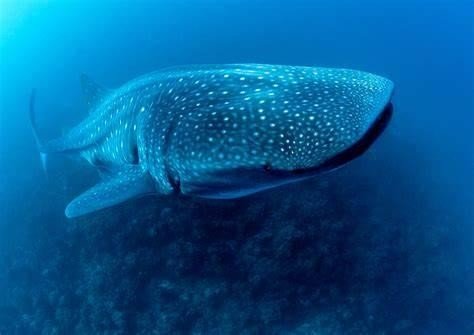
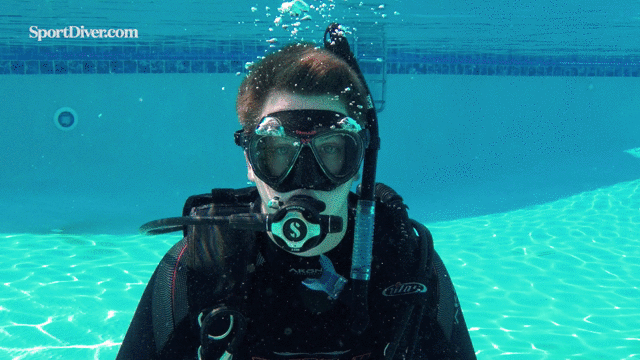
Whale Sharks ဝေလငါးမန်းများ
The whale shark (Rhincodon typus) is a slow-moving, filter-feeding carpet shark and the largest known extant fish species. The largest confirmed individual had a length of 18.8 m (61.7 ft). The whale shark holds many records for size in the animal kingdom, most notably being by far the largest living nonmammalian vertebrate. The whale shark is found in open waters of the tropical oceans and is rarely found in water below 21°C (70°F). Studies looking at vertebral growth bands and the growth rates of free-swimming sharks have estimated whale shark lifespans at 80–130 years. Whale sharks have very large mouths and are filter feeders, which is a feeding mode that occurs in only two other sharks, the megamouth shark and the basking shark. The name "whale shark" refers to the fish's size, being as large as some species of whales, and also to its being a filter feeder like baleen whales.

ငါးလိပ်ပြာ
အန်ဂျယ်ငါး ၏ နီးစပ် သော မျိုးစိတ် တစ်ခုဖြစ်သော ၊ လိပ်ပြာ ငါး များ သည် ရုပ်ပိုင်းဆိုင်ရာ စရိုက်လက္ခဏာ များ စွာ ရှိ သော်လည်း သူ တို့ ၏ အဓိက ခန္ဓာကိုယ် မှ ထွက် လာ တတ် သော သူ တို့ ၏ ခိုင်မာ သော ၊ ပါးလွှာ သော " နှာခေါင်း များ " ကြောင့် အများအားဖြင့် အန်ဂျဲလ် ငါး နှင့် ကွဲပြား သည် ။ အလားတူ အလွန်အရောင်တောက်ပြီး (ထင်ရှားသောအရောင်ဖြင့်) ယင်းတို့သည် သက်တံရောင်ရှိသော ပင်လယ်သတ္တဝါများဖြစ်သည်။ လိပ်ပြာငါးများ၏ ခန္ဓာကိုယ်များသည် အလွန်ပါးလွှာပြီး သန္တာကျောက်တန်းပေါ်တွင် ပေါက်နေသော သန္တာကျောက်တန်းများ သို့မဟုတ် ရေညှိများကို ပုံမှန်အစားအစာအဖြစ် စားသောက်နိုင်ရန် လမ်းကြောင်းငယ်များမှတစ်ဆင့် လမ်းကြောင်းရှာဖွေရန် ကူညီပေးသည်။ လိပ်ပြာငါးတွေဟာ သူတို့ရဲ့အိမ်ထောင်ဖက်တွေကို မယုံနိုင်အောင် သစ္စာစောင့်သိတဲ့အတွက်လည်း လူသိများကြပါတယ်။
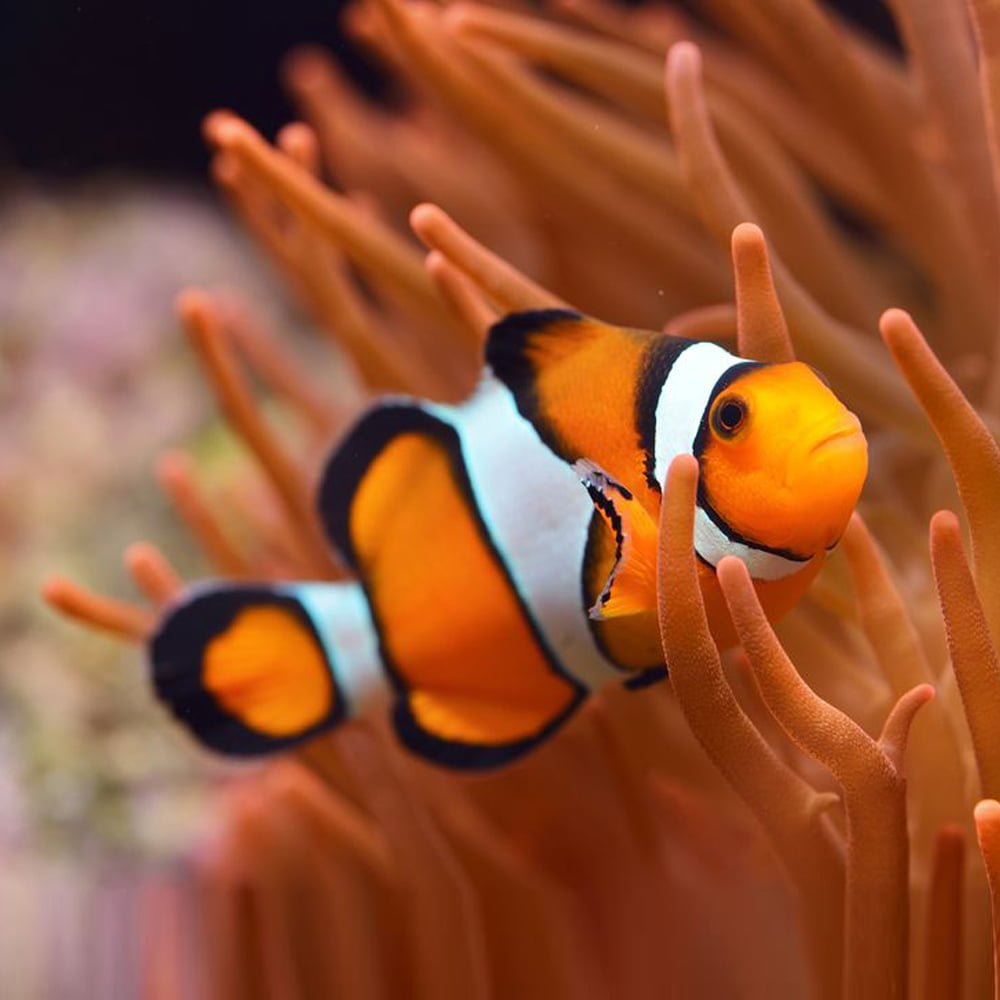
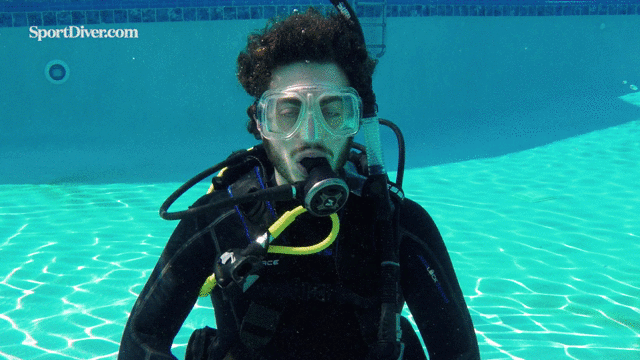
နီမိုငါး
အနီမိုးငါးဟုလည်း လူသိများသည့် ကလောင်းငါးများသည် ဒစ္စနေး/ပစ်ကာ၏ ရိုက်ကူးထားသော CGI ရုပ်ရှင် စီဂျီအိုင် ရုပ်ရှင် နီမိုကြောင့် မကြာသေးမီက နိုင်ငံတကာကျော်ကြားမှုသို့ ပေါက်ရောက်ခဲ့သည်။ အနီမုန်းငါးများသည် ရေငုပ်နေသောအသိုင်းအဝိုင်းတွင် အလွန်လူကြိုက်များပြီး အထူးသဖြင့် ကလောင်းငါးများသည် အများအားဖြင့် တောက်ပသော လိမ္မော်ရောင် သို့မဟုတ် အပြာရောင် ပါသည့် တောက်ပသော လိမ္မော်ရောင်အရောင်ဖြင့် ဖော်ပြထားသည်။ သူ တို့ ၏ နေထိုင် ရာ နေရာ များ မှာ သူ တို့ ၏ အမည် မှ ဆင်းသက် လာ သော ပင်လယ် မှ ပင်လယ်မှို များ ဖြစ် ကြ သည် ။ ကလောင်းငါးများသည် ငါးများအပေါ် ပြင်းထန်သော ခြိမ်းခြောက်မှုမှန်သမျှကို အဆိပ်သင့်စေမည့် ပင်လယ်မုန်းများကြားတွင် မိမိကိုယ်ကို အသိုက်ဆောက်နိုင်သောကြောင့် ယင်းသည် ဖြတ်သန်းသွားလာနေသော သားရဲများကို ဆန့်ကျင်သည့် သဘာဝကာကွယ်ရေးစနစ်တစ်ခုအဖြစ် လုပ်ဆောင်သည်။ အရွယ်အစားသေးငယ်သော်လည်း ကလောင်းငါး များ သည် လည်း ငွေဆောင် တွင် နေထိုင် ရန် သူ တို့ ၏ သဘောထား ကြောင့် အလွယ်တကူ ရရှိ နိုင် သော ငါး မျိုးစိတ် များ ထဲမှ တစ် မျိုး ဖြစ် ခြင်း အတွက် လည်း လူ ကြိုက် များ သည် ၊ ၎င်း တို့ ကို ကျောက်တန်း ၏ နက်ရှိုင်း သော နေရာ များ ထဲ သို့ နောက်ထပ် ရေငုပ် ရန် မ လိုအပ် ဘဲ မြှောက်ပင့် သူ များ က မကြာခဏ မြင် နိုင် စေ သည်။
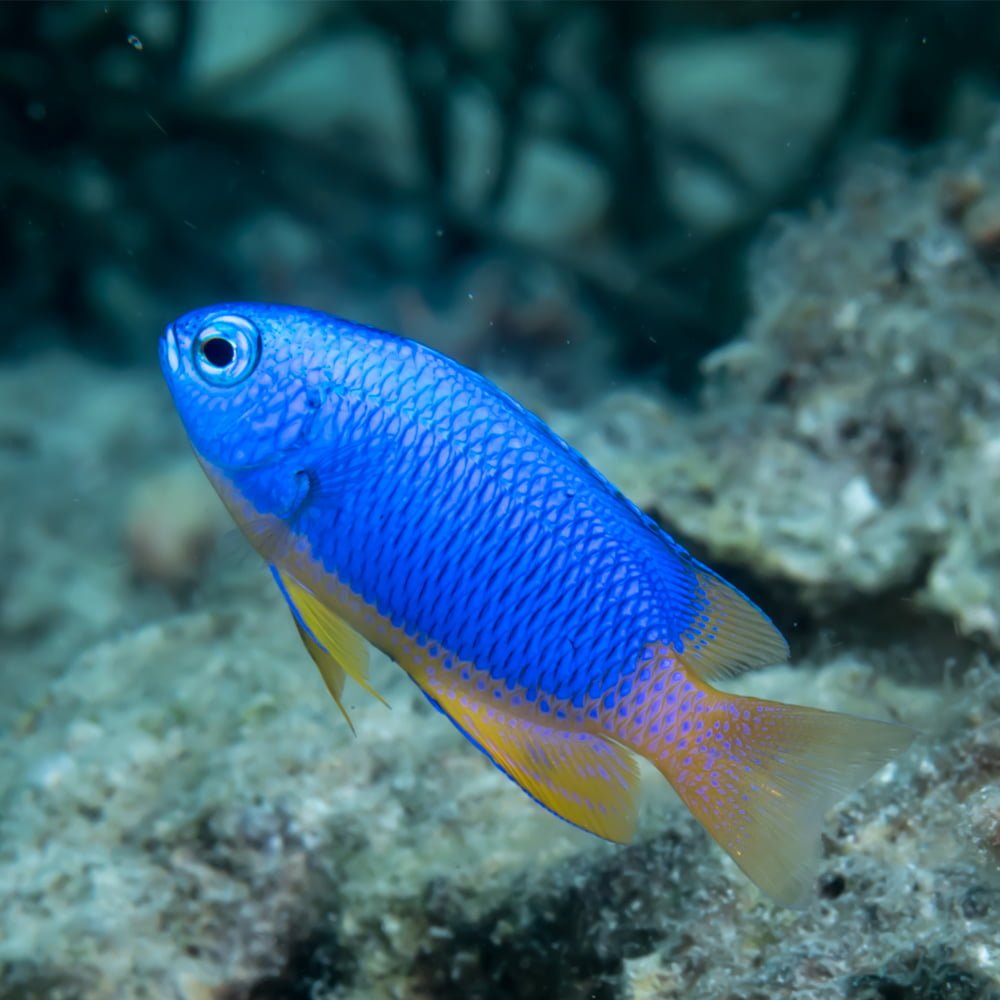
Damsels အပျိုစင်ငါး
အံ့သြဖွယ်ကောင်းလောက်အောင် တောက်ပတဲ့အရောင်တွေကနေ အရောင်မှိန်တာအထိ ငွေဆောင်မှာ တွေ့ရတဲ့ အများဆုံးမျိုးစိတ်တွေထဲက တစ်ခုဖြစ်ပြီး နေရာတိုင်းနီးပါးမှာ တွေ့မြင်နိုင်ပါတယ်။ အံ့ဩစရာကောင်းတာက သူတို့ရဲ့အရွယ်အစားနဲ့ အရောင်အမျိုးမျိုးအတွက် နယ်မြေဖြစ်တယ်။ သူ တို့ သည် သူ တို့ ကိုယ်တိုင် ထက် ပိုကြီး သော သားကောင် များ ကို ဆန့်ကျင်ရန် သူ တို့ ၏ သဘာ၀နှင့်အတူ ကာကွယ် ပေး မည့် သန္တာကျောက်တန်း များ အကြား သတ်မှတ် ထား သော " နေရာ " တစ် ခု တွင်သာပုံမှန်အားဖြင့် နေထိုင်သည် ။ မျိုးစိတ်များအပေါ်မူတည်၍ ပလန်တန်စားသုံးသူများသည် အများအားဖြင့် တောက်ပသောအရောင်များရှိပြီး ရေညှိစားသုံးသူများသည် လိမ္မော်ရောင်နှင့် အညိုရောင်များဖြစ်ကြသည်။
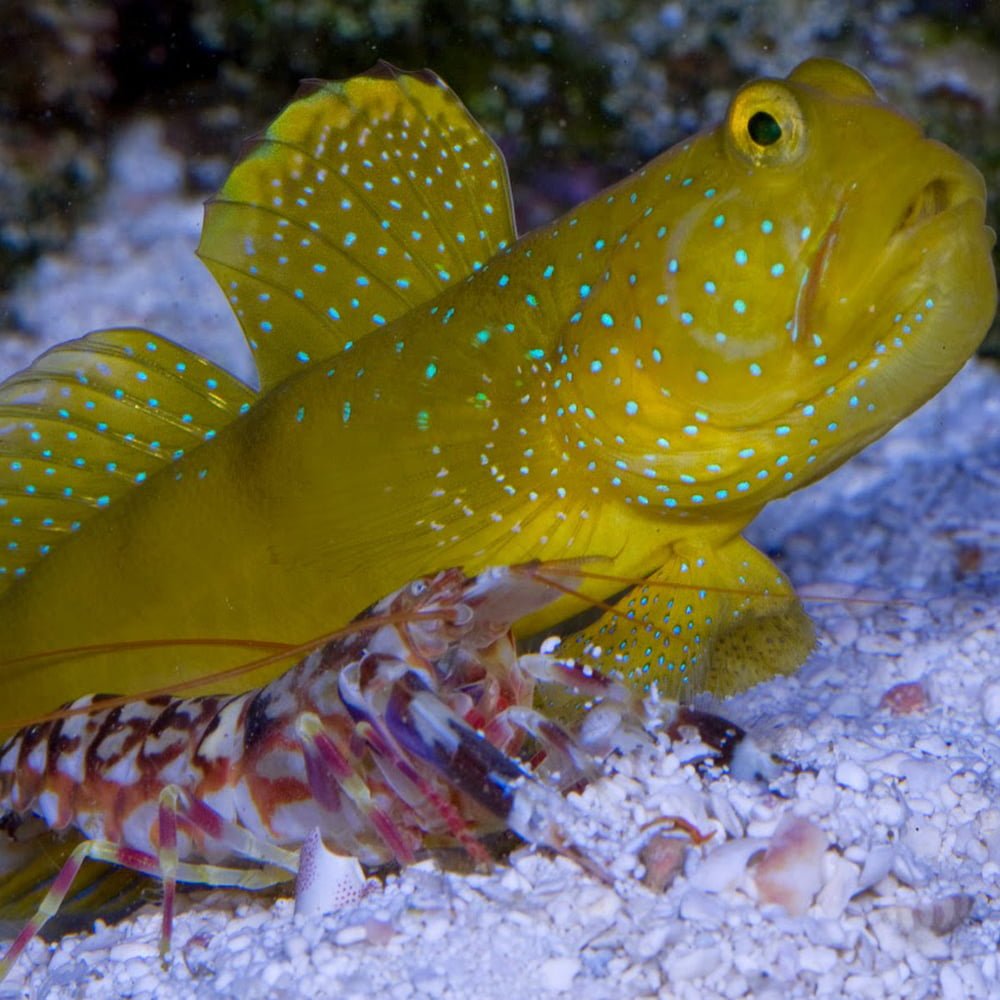
ရေအောက်ခြေတွင်တွေ့ရသောငါးများ
ငါးပုတ်သင်
ဂေါ်ဘီလူမျိုးများသည် အရွယ်အစားအနည်းငယ်သာရှိပြီး တိုတောင်းသောငါးမျိုးနွယ်စုကြီးတစ်ခုဖြစ်သည်။ ဂေါ်ဘီများအတွက် ဝမ်းနည်းစရာမှာ သူတို့သည် တူညီသောနေထိုင်ရာဒေသအတွင်း သားကောင်အမြောက်အမြားအတွက် သားကောင်အဖြစ် ဆောင်ရွက်ကြစဉ် ငွေဆောင်၏ ဂေဟစနစ်အတွင်း စာနာထောက်ထားသော်လည်း မရှိမဖြစ်လိုအပ်သော လုပ်ဆောင်မှုတစ်ခုကို လုပ်ဆောင်ကြသည်။ ဂိုဘီများသည် အဓိကအားဖြင့် သန္တာကျောက်တန်း၏ အောက်ခြေအဆင့်များတွင် နေထိုင်ကြပြီး အများအားဖြင့် သားရဲများထံမှရှောင်ရှားရန် အုပ်စုငယ်လေးများတွင် တစ်ယောက်တည်း သို့မဟုတ် အုပ်စုငယ်များဖြင့် ခရီးသွားလေ့ရှိသည်။
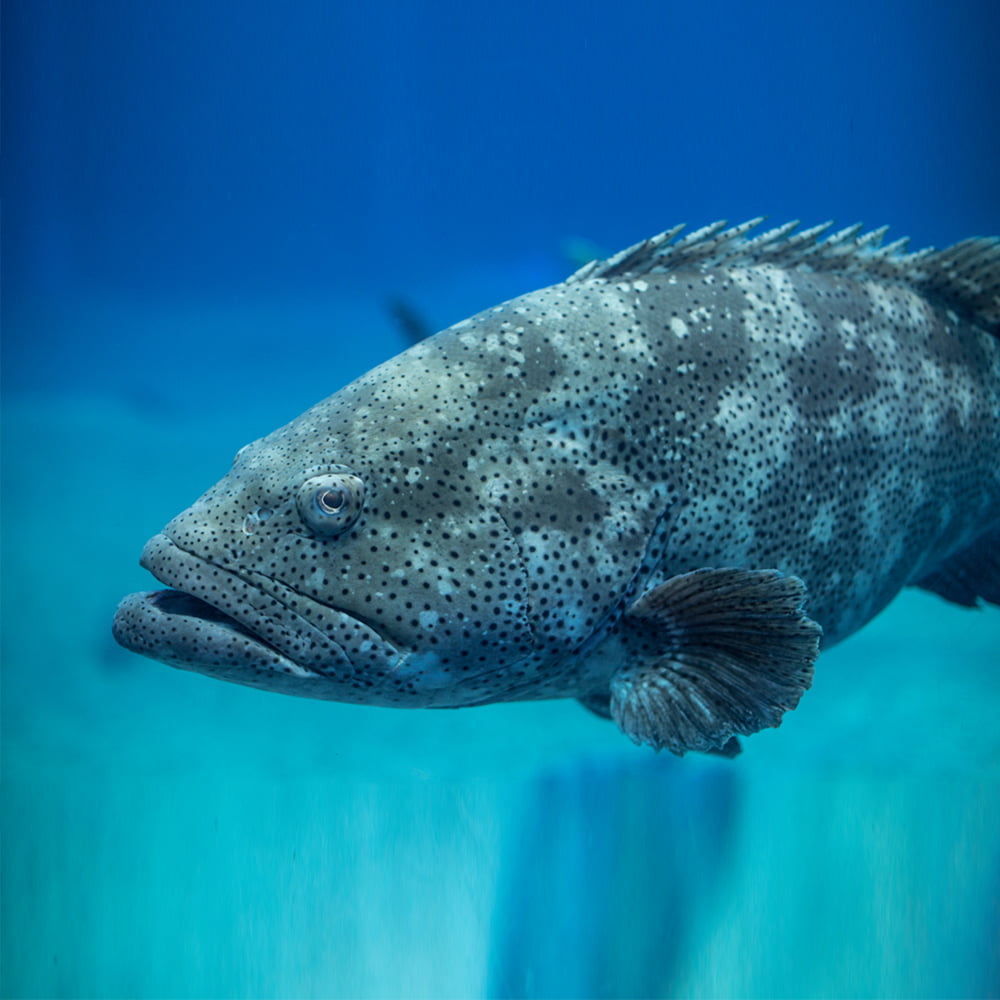
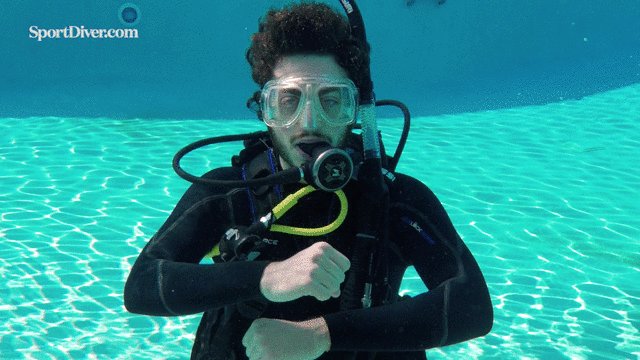
ကျောက်ငါး၊ ကော့ဒ်
ကြီးမားပြီး၊ နှေးကွေးတဲ့ သန္တာကျောက်တန်း နေထိုင် သူ များ သည် သူ တို့ ၏ ခိုင်ခံ့ သော ခန္ဓာကိုယ် များ နှင့် ပါးစပ် ကြီး များ ဖြင့် သရုပ်ဖော် ထား ပြီး ၊ အ ကြီး ဆုံး အဖွဲ့ဝင် များ သည် စင်တီမီတာ ၂၇၀ အထိ ရှည်လျား ပြီး အလေးချိန် ၄၀၀ ကီလိုဂရမ် ကျော် တွင် အလေးချိန် ရှိ ခြင်း နှင့်အတူ ၊ငွေဆောင် တွင် တွေ့ ရှိ နိုင် သော အ ကြီး ဆုံး ငါး အချို့ ဖြစ် သည် ။ ကံကောင်းတာက သူတို့ဟာ အန္တရာယ်ကင်းပြီး တကယ်တော့ တော်တော်လေး လူမှုရေး သတ္တဝါတွေဖြစ်ကြပြီး မကြာသေးခင်က မှတ်ဉာဏ်ထဲက ရေငုပ်သူတွေအတွက် ဓာတ်ပုံရိုက်ဖို့အခွင့်အလမ်းကြီးတွေ ရရှိကြပါတယ်။ အမြင်အာရုံမှာ အများအားဖြင့် အရောင်တွေထဲမှာ အတော်လေး နိမ့်ကျနေပေမဲ့ အများအားဖြင့် အညိုရောင်တွေနဲ့ အညိုရောင်တွေပါဝင်တဲ့ အရောင်တွေနဲ့ အတော်လေး နိမ့်ကျနေပါတယ်။ သူတို့၏ အရွယ်အစား နှင့် လိမ်လည်မှု သဘာဝ သည် ၎င်း အတွက် ဖြည့်ဆည်း ပေးသည်ထက်ပို ၍ သူ တို့ ၏ ပမာဏ များ စွာ က သန္တာကျောက်တန်း ၏ နက်ရှိုင်း သော ဒေသ အချို့ သို့ စွန့်စား ခြင်း သည် ဖော်ပြ ချက် အချို့ ၏ အုပ်စု တစ်စု နှင့် တွေ့ဆုံ မှု တစ် ခု ကို အမှန်တကယ် ဖြစ် ပေါ် စေ လိမ့်မည် ဟု ဆိုလို သည် ။
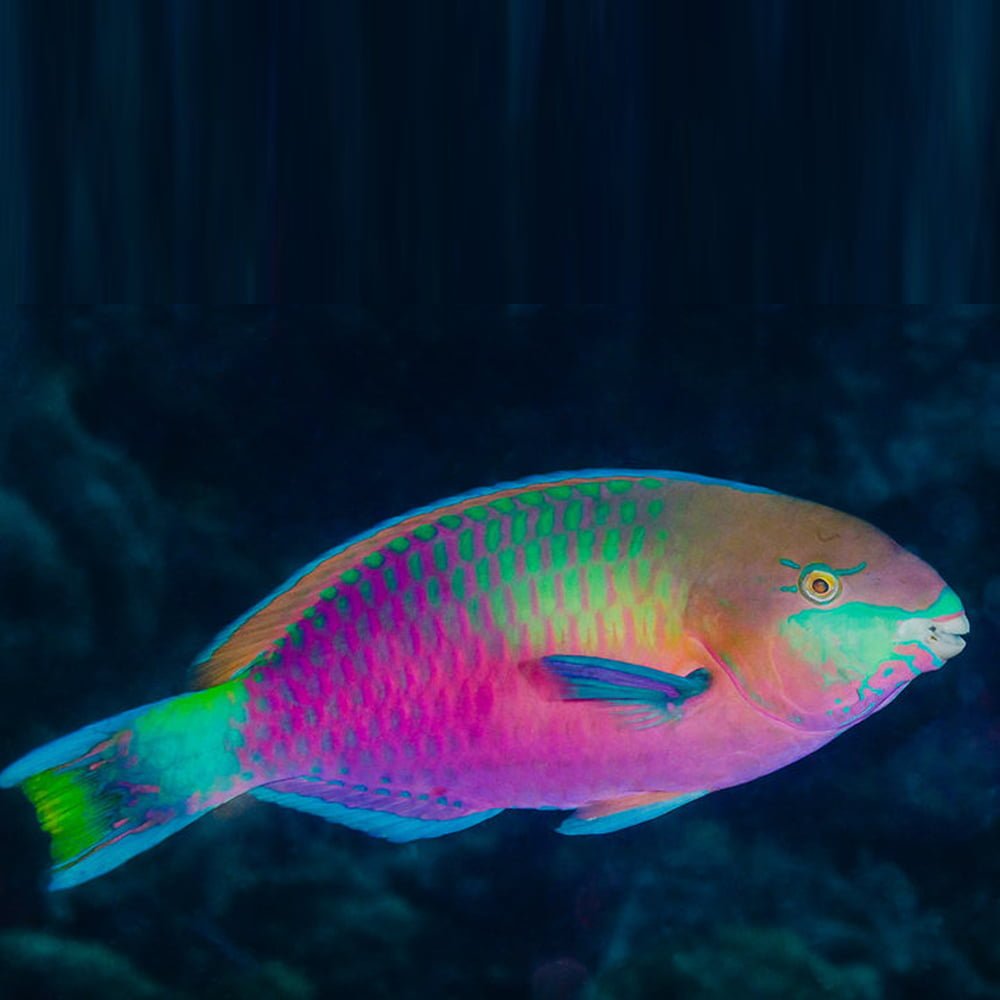
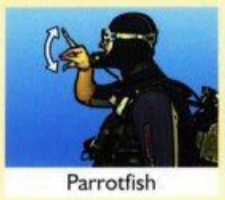
Parrotfisငါးကြက်တူရွှေး
Parrot fishes spend 90% of their day eating algae and dead coral. They clean our reefs. This makes them an important part of our ecosystem. Most of the reefs across the tropics are full of algae due to overfishing of the parrot fish and other herbivores. The parrot fish also poops up to 700 pounds of fine white sand annually. Their existence is essential so avoid eating them. Educate your friends and family to raise awareness. Say no to catching parrot fishes. Don't purchase them from the markets. ငါးတစ်ကောင်မှာ ကြက်တူရွေးနဲ့ ဘယ်လိုတူနိုင်သလဲ။ ပထမဦးဆုံးအကြိမ် ကြက်တူရွေးတစ်ကောင်ကို မြင်ရတဲ့အခါ သူတို့ရဲ့ပါးစပ်တွေဟာ ကြက်တူရွေးရဲ့ နှုတ်ခမ်းနဲ့ ခြားနားတဲ့ နှုတ်ခမ်းနဲ့ ဆင်တူတယ်၊ သန္တာရဲ့ မာကျောတဲ့ အစိတ်အပိုင်းတွေကို ကိုက်ဖို့ သူတို့အသုံးပြုကြတယ်။ အခြေခံ အားဖြင့် " အလယ်အလတ် " သန္တာကျောက်တန်း တစ် ခု ဖြစ် ပြီး သူ တို့ ၏ ကိုယ်ခန္ဓာ ပေါ်တွင် အရောင် များ စွာ ရှိ သော ပုံစံ များ နှင့်အတူ ၊ သူ တို့ သည် ငွေဆောင်တွင် အမြင်သာဆုံး မျိုးစိတ် များ ထဲမှ တစ် ခု ဖြစ် ပြီး သူ တို့ နေထိုင် သော ရေ များ ကို ထပ်ဆင့် အရောင်စုံ ဖြင့် ဖြည့်ဆည်း ပေး ရန် ကူညီ ပေး သည် ။ သူ တို့ ၏ ထင်ရှား သော သဘောသဘာဝ ကို အထောက်အကူ ပြု ခြင်း သည် သူတို့သည် ကျောက်တန်း၏ ရေပြင်၏ အတော်အတန် နက်ရှိုင်းသော အစိတ်အပိုင်းများတွင် နေထိုင်ကြခြင်းဖြစ်ပြီး၊ ငွေဆောင် တွင် စွန့်စား နေ သော မြှောက်ပင့် သူ များ က မကြာခဏ မြင်ကွင်း တစ် ခု ဖြစ် စေ သည်။ ကျောက်တန်းကိုယ်နှိုက်ရဲ့ ဖွံ့ဖြိုးတိုးတက်မှုနဲ့ ကြီးထွားမှုကို အထောက်အကူပြုတဲ့ ထူးခြားတဲ့ အလေ့အထတစ်ခုလည်း ရှိပါတယ်။ သန္တာကျောက်တန်းတွေနဲ့ သွားတွေကိုသုံးပြီး သန္တာကျောက်တန်းတွေကို ကြိတ်ပြီး ကမ္ဘာတစ်ဝန်းမှာရှိတဲ့ ကျွန်းငယ်လေးတွေနဲ့ သဲကမ်းခြေလေးတွေ ဖန်တီးဖို့ အချိန်မီ ကူညီပေးတဲ့ သဲအဖြစ် ထုတ်ယူကြတယ်။

Surgeonfish စီးတော်ရှင်
ငွေဆောင်တစ်ခုလုံးရှိ အမြင်အာရုံအထင်အရှားဆုံးငါးအချို့သည် မျိုးစိတ်များနှင့် ပုံမှန်ဖြစ်သော ပုံစံများနှင့် အပိုင်းအစများနှင့် ပေါင်းစပ်ထားရာ ရလဒ်အနေနှင့် လူတို့သည် အိမ်တွင်းရေမြှုပ်ကောင်များတွင် နေထိုင်ရန် အလွန်ရေပန်းစားနေသည်။ Surgeon ငါး များ သည် သူ တို့ ၏ ကိုယ်ခန္ဓာ မှ ထွက် လာ သော သူ တို့ ၏ ထိုးဖောက် ထား သော ဓား နှင့် အဆိပ် ရှိ သော တောင်ပံ ကျောရိုး များ မှ သူ တို့ ၏ အမည် ကို ရရှိ ပြီး နယ်မြေ ဆိုင်ရာ အငြင်းပွား မှု များ တွင် ပါဝင် နေ စဉ် မျိုးစိတ် တစ် ခု တည်း ၏ သားရဲ များ နှင့် မျိုးစိတ် ချင်း များ မှ မိမိ တို့ ကိုယ် ကို ကာကွယ် ရန် အသုံးပြု ကြ သည်။ Surgeon ငါးတွေနေတဲ့ ရောင်စုံအသိုက်တွေကိုလည်း ကျောက်တန်းတွေပေါ်မှာ မကြာခဏ မြင်ကွင်းတစ်ခုဖြစ်ပြီး သန္တာကျောက်တန်းကို မြှင့်တင်ရန် ရှာဖွေနေသော ပို့စကတ်များနှင့် မဂ္ဂဇင်းဓာတ်ပုံရိုက်ကူးမှုများစွာ၏ အကြောင်းအရာဖြစ်သည်။
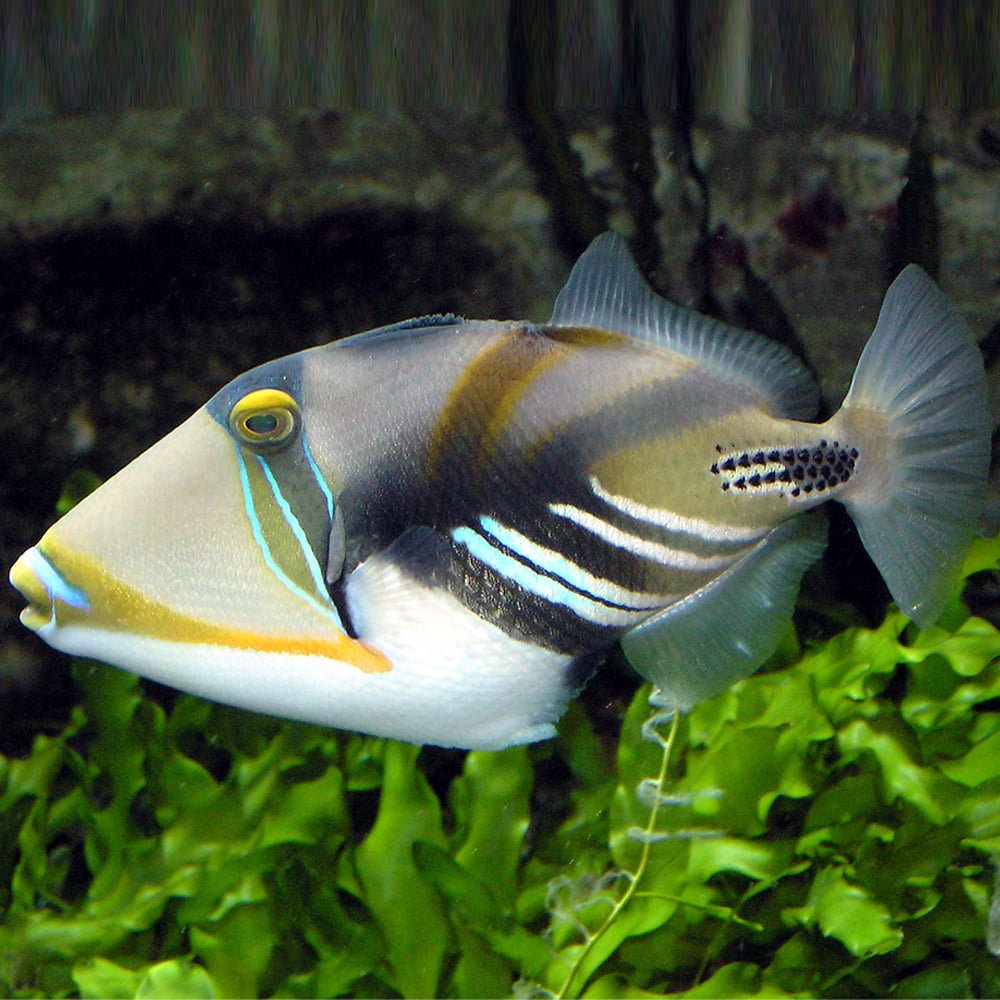
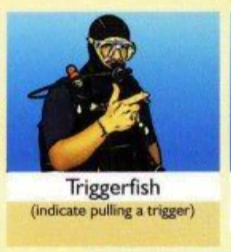
Triggerfish ငါးသန် Triggerfish ငါးသန်
တောက်ပတဲ့ အရောင်နဲ့ ထူးခြားတဲ့ "ပွတ်တီ" ပါးစပ်နဲ့အတူ ထရစ်ဂါငါးငါးတွေဟာ ငွေဆောင်မှာ အလွယ်တကူ မှတ်မိနိုင်ဆုံး အသိအမှတ်ပြုရဆုံး ငါးမျိုးစိတ်တွေထဲက တစ်ခုဖြစ်ပါတယ်။ ငါးတစ်ကောင်နဲ့တစ်ခု မတူတဲ့ လိုင်းတွေ၊ အစက်အပြောက်တွေနဲ့ တခြားပုံစံအမျိုးမျိုးဟာ ထရစ်ဂါငါးမိသားစုရဲ့ အမှတ်လက္ခဏာတစ်ခုဖြစ်ပြီး Surgeon ငါးတွေလိုပဲ နောက်ထပ်ရေပန်းစားတဲ့ အသွင်အပြင်တစ်ခုပါပဲ။ သူ တို့ ၏ အသွင်အပြင် အပြင် ၊ ထရစ်ဂါငါး များ သည် သူ တို့ ၏ အသွင်အပြင် အပြင် ၊ သူ တို့ ၏ ၊ ရန်လိုတတ်သော အမူကျင့်များကြောင့်၃ကျော်ကြား သည် ၊ ရန်လို တတ် ပြီး မကြာခဏ ကိုက် လေ့ ရှိ သော ငါး များ နှင့် အရွယ်အစား ပို သေး ငယ် သော လူ များ ပင် ဖြစ် သည် ။ သူ တို့ တွင် မော်လစကစ် များ ၊ ပင်လယ် ယူချင် များ နှင့် အခြား ခရူးစတင်း များ ကဲ့သို့ ပင်လယ် မာကျော သော ပင်လယ် အဖွဲ့အစည်း များ ၏ အစားအစာ ကို စားသုံး ရန် သူ တို့ အသုံးပြု သော ခိုင်ခံ့ သော မေးရိုး များ ရှိ ပြီး၊ ထို့ကြောင့် သူ တို့ ၏ ကိုက် ခြင်း သည် လူ့ အရေပြား ကို ကိုက် သောအခါ အတော်အတန် နက်ရှိုင်း စွာ ထိုးဖောက် နိုင် သည်။
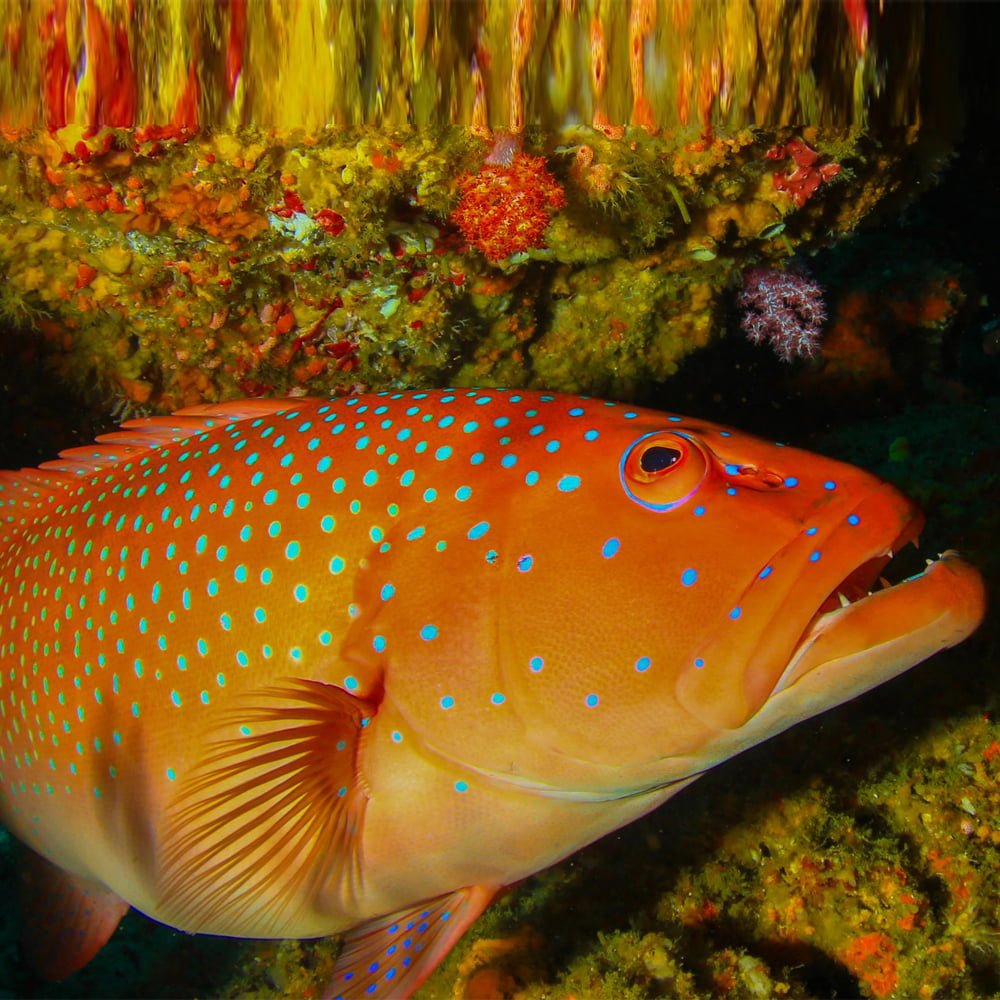
Trout ထရောက် Trout ထရောက်
သူတို့၏ အရသာကြောင့် နိုင်ငံခြား ဈေးကွက် များတွင် မြင့်မားသော ဈေးနှုန်း တစ်ခုသည် ၏။ သန္တာကျောက်တန်း၏အစားအစာဆက်သွယ်မှုတွင် သန္တာကျောက်တန်းကိုယ်နှိုက်တွင် အတော်အတန်မြင့်မားပြီး အခြားငါးငယ်များစွာပါဝင်သည့် အစားအစာ (ဒမ်တစ်ရှစ်ရှ်သည် အထူးနှစ်သက်သူတစ်ဦးဖြစ်ခြင်းနှင့်အတူ) အစားအစာပါဝင်သည်။ ကော်ရယ် ထရွတ် ၏ အမြင်အာရုံ အံ့သြ ဖွယ် အ ကောင်း ဆုံး အရည်အသွေး များ ထဲမှ တစ် ခု မှာ ကျူးဘား ရေငုပ် သောအခါ သက်သေခံ ရန် အံ့ဩ ဖွယ် မြင်ကွင်း တစ် ခု ဖြစ် သော ၊ အမျိုးသမီး တစ် ဦး ကို ဆင်းသက် ရန် ကြိုးစား နေ သော ပျော် ရွှင် မှု ပြသ မှု များ ကို တင်ဆက် သောအခါ ၎င်း ၏ အရောင် ကို ချက်ချင်း ပြောင်းလဲ ရန် အမျိုးသား ၏ စွမ်းရည် ဖြစ် သည် ။ မျိုးစိတ်များအပေါ်မူတည်၍ ကော်ရယ်ထရွတ်သည် အများအားဖြင့် အရွယ်အစား ၇၀ မှ ၁၂၀ စင်တီမီတာအထိ စိုက်ပျိုးလေ့ရှိသည်။
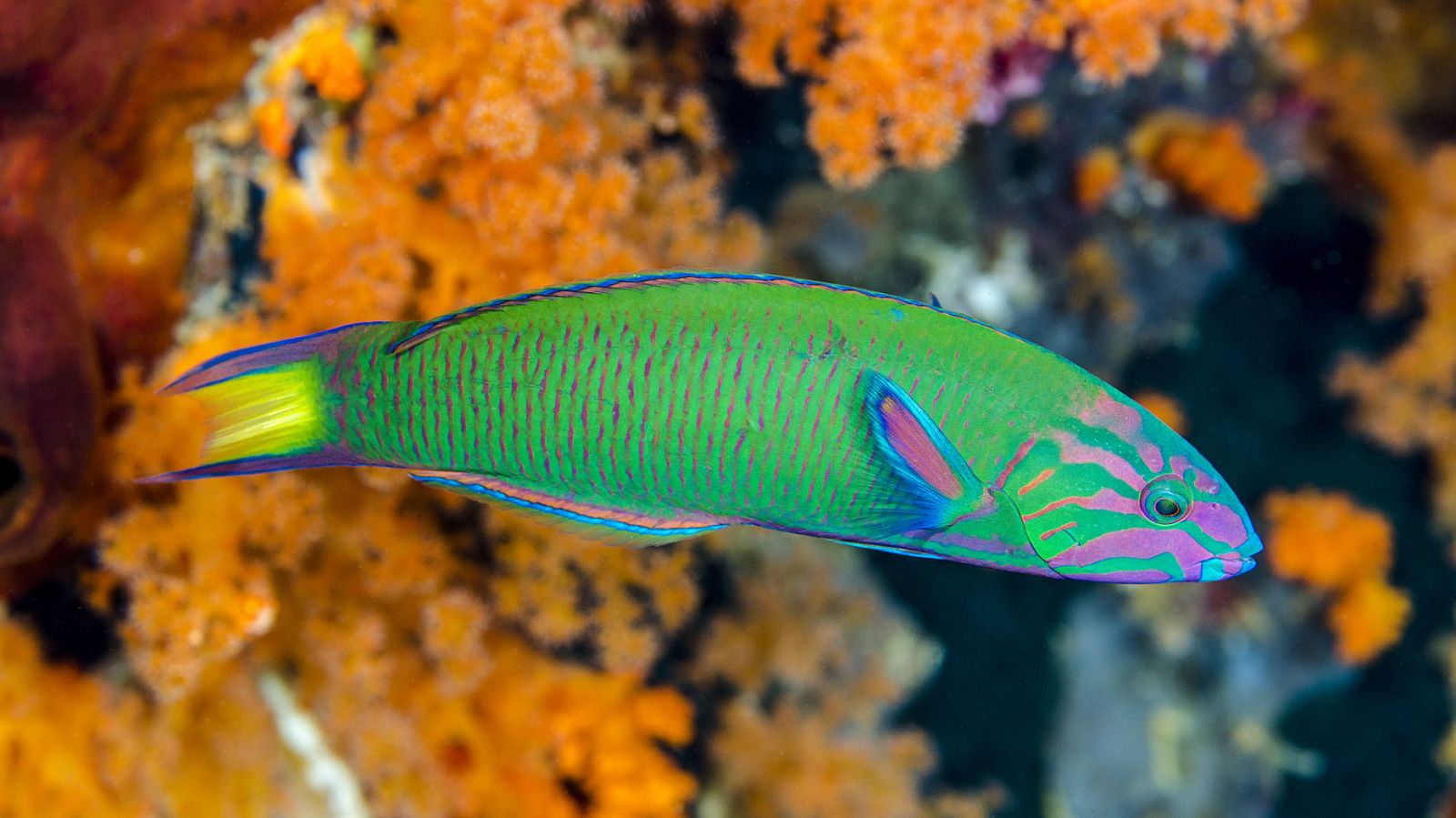
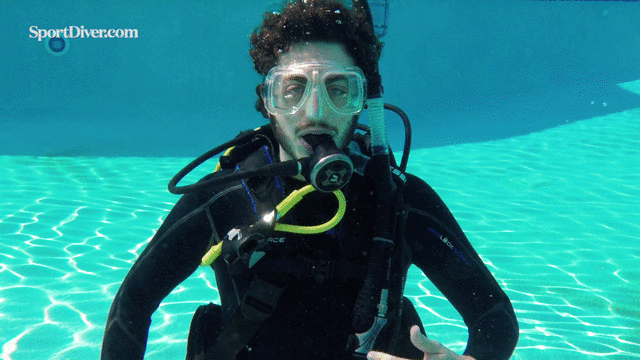
Wrasse ငါးချောသားWrasse ငါးချောသား
ငွေဆောင်တွင် တွေ့ရသော ဝရက်စ်မျိုးစိတ်များမှာ အလွန်ထူးခြားသော အသွင်အပြင်ရှိ ငါးတစ်ကောင်ဖြစ်သည့် ဟမ်ဖီးဒ် သို့မဟုတ် မာအိုရီဝရက်စ်ဖြစ်ပြီး နဖူးပေါ်ရှိ ကျောရိုးကြီးဖြစ်သည်။ ကျောက်တန်းထဲမှာတွေ့ရတဲ့ အကြီးဆုံးငါးတွေထဲက တစ်ခုဖြစ်ပြီး နဖူးကိုသာမက သူတို့ရဲ့ ထူထဲတဲ့ "နှုတ်ခမ်းတွေ" ကိုပါ ခွဲခြားသိမြင်နိုင်ပါတယ်။ မာအိုရီဝရက်စ်သည် ငွေဆောင်တစ်ခုလုံးတွင် အသက်အရှည်ဆုံးငါးတစ်ကောင်လည်းဖြစ်ပြီး အသက် ၃၀ ကျော်အသက်ရှင်ခဲ့ကြောင်း လူသိများကြသည်။ ဤအချက်ရှိလင့်ကစား လက်ရှိတွင် အရသာရှိသောအစားအစာအဖြစ် သူတို့၏ဂုဏ်သတင်းကြောင့် အန္တရာယ်ကြုံနေရသည့် မျိုးစိတ်များအဖြစ် စာရင်းသွင်းထားပြီး ယခင်က အကြီးအကျယ် ငါးဖမ်းခံခဲ့ရသည်။ မာအိုရီ ဝရက်စ်စီ သည် အလျား နှစ် မီတာ အထိ ကြီးထွား နိုင် ပြီး ၊ သူ တို့ ၏ ထူးခြား သော အရောင် နှင့် ထူးခြား သော နဖူး တို့ ပေါင်း စပ် ထား ခြင်း သည် ကဲန်းစ် နှင့် ပေါ့ ဒေါက်ဂလပ် ကဲ့သို့ ကမ်းရိုးတန်း အနား ရှိ သန္တာကျောက်တန်း ၏ ရေပြင်တွင် ရေငုပ်သမားများအတွက် ရှာဖွေမှုအများဆုံးငါးများထဲမှ တစ်ခု ဖြစ်သည်။
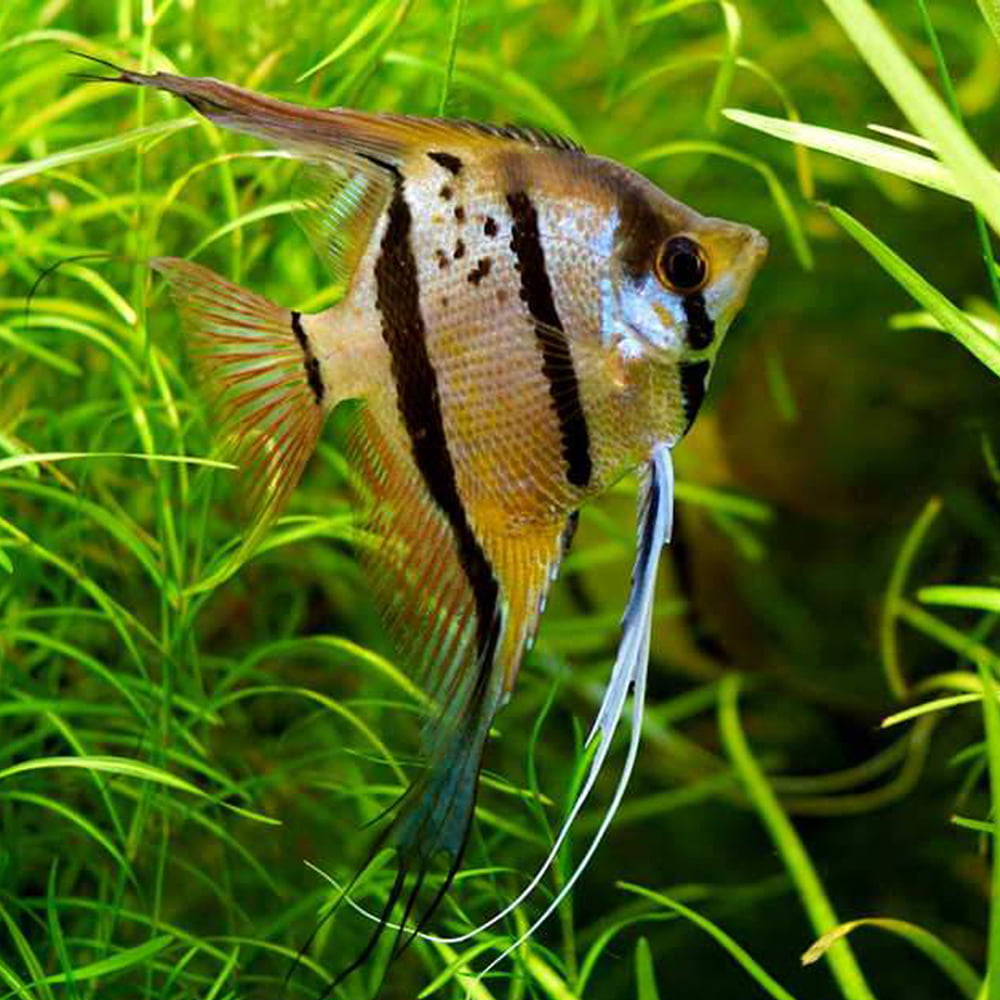
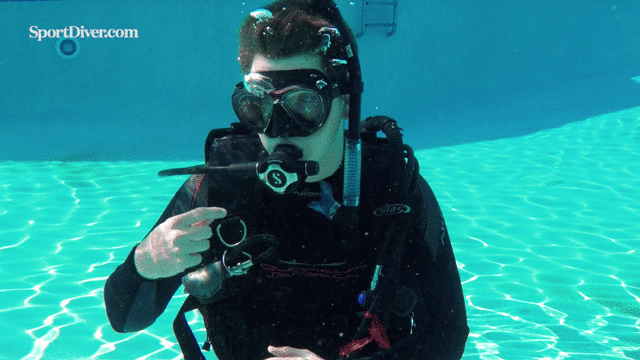
Angle Fish ငါးနတ်သမီး
အန်ဂျယ်ငါးများသည် ၎င်းတို့၏ထူးခြားသောပုံစံနှင့် ရောင်စုံအမှတ်အသားများကြောင့် လူသိများသည်။ အိန်ဂျယ်ငါးများသည် ငွေဆောင်တွင် စုစုပေါင်း မျိုးစိတ်ပေါင်း ၈၀ ကျော်ရှိသည်။ အိန်ဂျယ်ငါး၏ ပုံမှန်လက္ခဏာများတွင် ၎င်းတို့၏ အလှအပ၊ စူးစမ်းရှာဖွေရေးသဘာဝနှင့် ကျောက်တန်း၏ အထက်ပိုင်းတွင် တွေ့ရှိနိုင်သည့် လက္ခဏာတို့ပါဝင်သည်။ သန္တာကျောက်တန်းများ၏ မျက်နှာပြင်မှ အောက်ခြေအထိ တွေ့ရှိရသည်။ အိန်ဂျယ်ငါးပေါ်မှာ တွေ့နိုင်တဲ့ ပုံစံတွေဟာ ပိန်တာကနေ မိသားစုများ၏ ငါးနှစ်ကောင်ကို အတိအကျမတူအောင် ပြုလုပ်ပေးသည့် ရောင်စုံပုံစံများစွာကို ကွက်ကွက်ကွင်းကွင်း မြင်သာစေပြီး ရေအောက်ဓာတ်ပုံပညာစိတ်၀င်စားသူများကို အထူးဆွဲဆောင်လျှက်ရှိသည်။
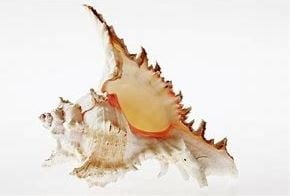
Ramose Murex
Also known as Branch Murex, Branched Murex, Branched Murex Shell, Jugged Shell, Murex Shell, Ramose Murex, Ram's Murex, Ram's Murex Shell. Found during the day on clean, coarse, rubble and sandy bottoms, sometimes partially buried, over coral and rocky reefs, emerging at night to feed. They feed nocturnally on bivalves and gastropods. Length - 30cm Depth - 0-50m Widespread Indo-Pacific Murex Shells feed on bivalves by boring a hole into the animal and inserting their proboscis to feed. They come in a range of colours and blend in with their surroundings. These shells are highly prized collectors items with their winged and pungent spines. Some look like walking skeleton shells.
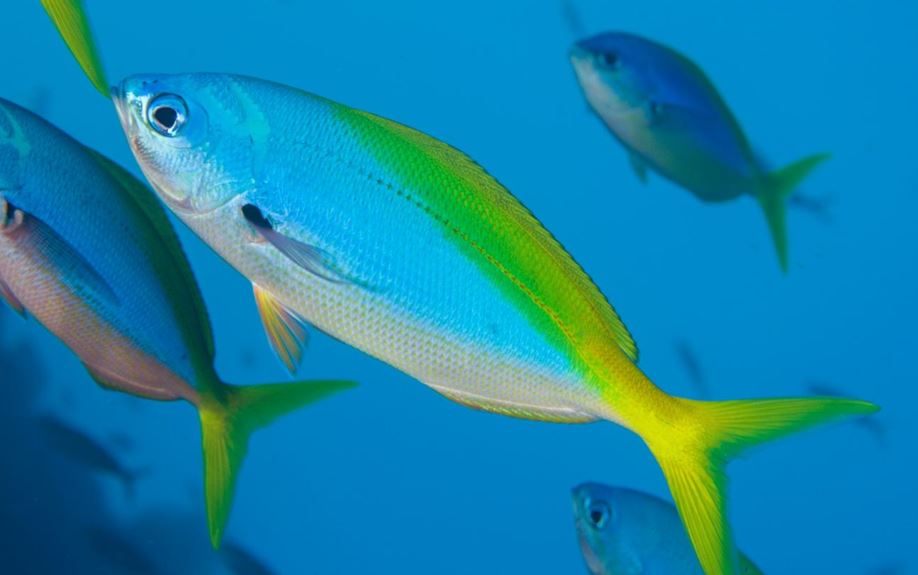
Yellowback fusilier ကျောရိုးဝါငါး
The yellowback fusilier (Caesio xanthonota) is a pelagic marine ray-finned fish, a fusilier belonging to the family Caesionidae. It is native to the tropical Indo-Pacific, being found in shallow water from the East African coast to Indonesia. The yellowback fusilier is a small to medium-sized fish which grows to about 40 cm (16 in) long. The mouth is small and terminal and is protusible, being able to be extended forward to swallow food. The body is fusiform or spindle-shaped. The dorsal fin has 10 spines and 14-15 soft rays. The anal fin has three spines and 11 or 12 soft rays. The caudal fin is deeply forked. The body coloration is greyish blue with a bright yellow zone on the back. The yellow area goes from the forehead, between the eyes, to the tail, and includes the dorsal fin and the caudal fin. This area corresponds more or less to the upper third of the body. The belly is plain white.

Emperor angelfish ဧကရာဇ် နတ်သမီး
The emperor angelfish shows a marked difference between the juveniles and the adults. The juveniles have a dark blue body which is marked with concentric curving lines, alternating between pale blue and white with the smallest which are completely enclosed within each other located posteriorly. These lines become vertical at the anterior end. The dorsal fin has a white margin and the caudal fin is transparent. The adults are striped with blue and yellow horizontal stripes, a light blue face with a dark blue mask over the eyes and a yellow caudal fin. There is a blackish band above the pectoral fins, the top of which is at the level of the upper orbit. The front margin of this band is bright blue and the rear margin is a thin yellow line. The anal fin has a dark blue background with lighter blue horizontal stripes. The dorsal fin has 13–14 spines and 17–21 soft rays while the anal fin has 3 spines and 18–21 soft rays. This species attains a maximum total length of 40 cm (16 in).
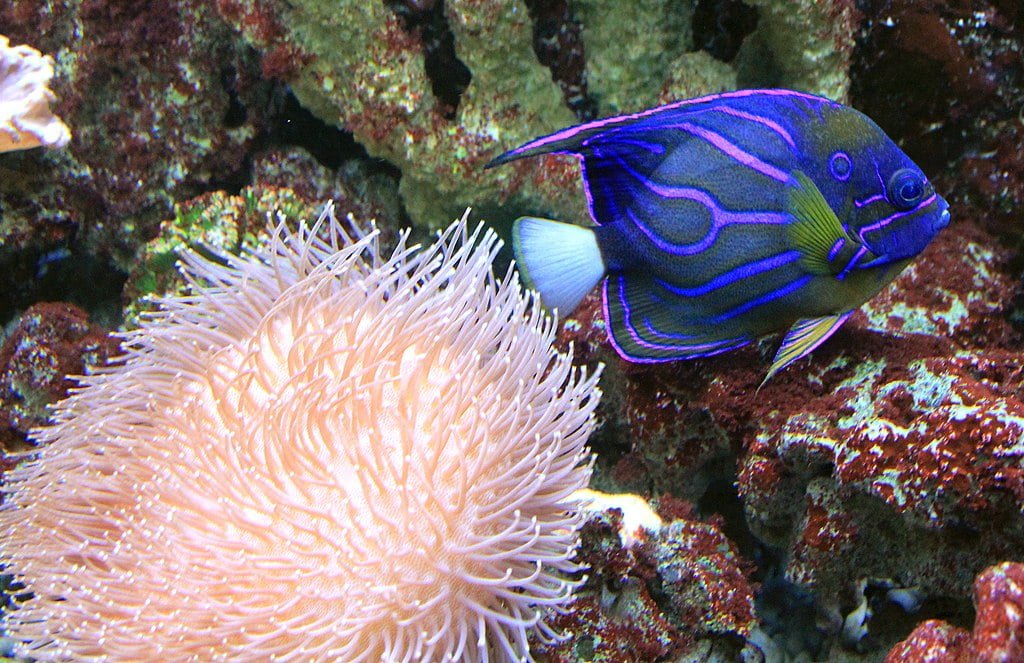
Blue Ringed Angelfish
Blue ringed angelfish have adults which are mainly yellow with the body marked with obvious arcing blue lines and a blue circle shaped mark above the operculum. They frequently have an elongated tip to the dorsal fin and they have a white caudal fin with a yellow margin. They also have a pair of blue stripes across the face, one runs through the eye and the second is situated immediately beneath the eye. The juveniles have a bluish-black overall color with thin white to blue colored curved lines on their body.The dorsal fin has 13 spines and 20-21 soft rays while the anal fin contains 3 spines and 20 soft rays. This species attains a maximum total length of 45 cm (18 in)
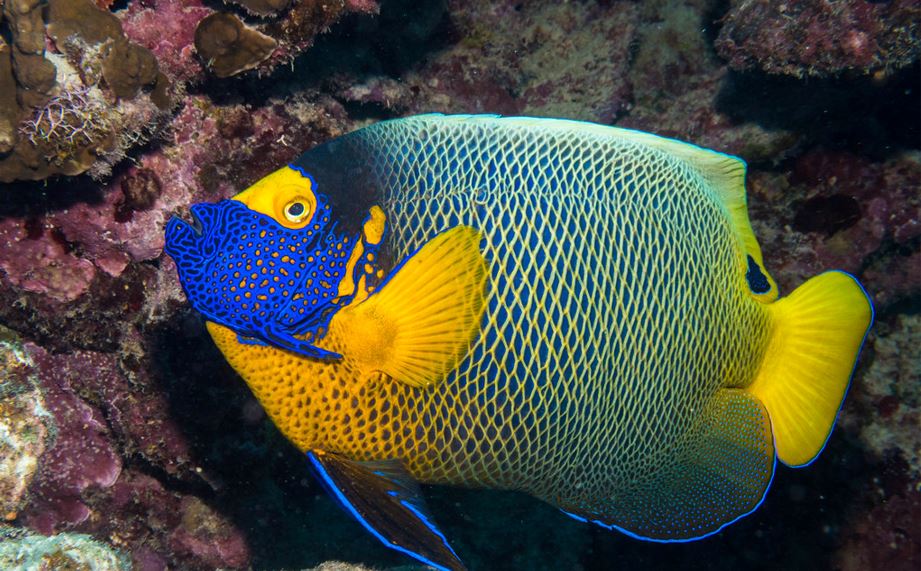
Yellow Masked Angelfish နှုတ်ခမ်းထူငါး
Pomacanthus xanthometopon is a marine ray-finned fish, a marine angelfish belonging to the family Pomacanthidae found in shallow parts of the Indo-Pacific. It is commonly known as the blueface angelfish or the yellowface angelfish because of its striking facial colouration.
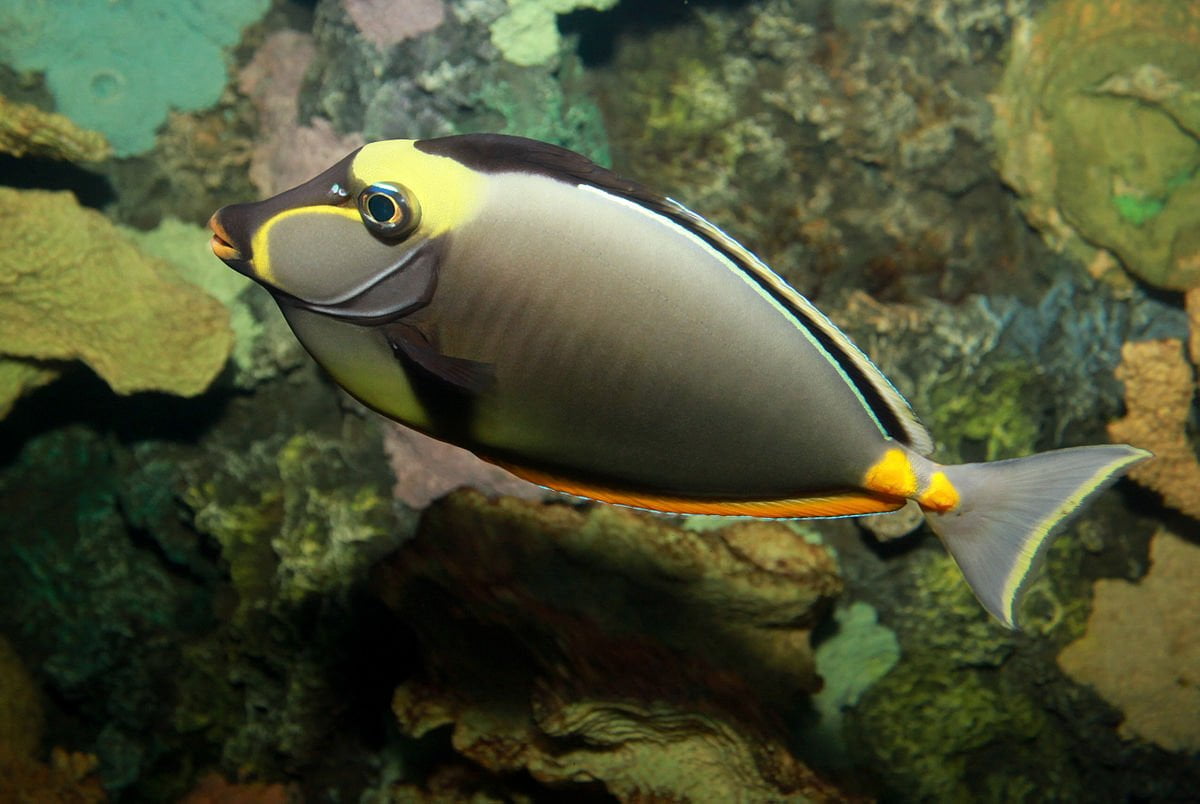
Orange spined Unicornfish လိမ္မော်ရောင်ကျောရိုးပါငါး
Naso lituratus is a species of fish in the family Acanthuridae, the tangs and unicornfishes. Its common names include barcheek unicornfish, naso tang, and orange-spine unicornfish. Unique to members of Acanthuridae, including Naso lituratus, are the Epulopiscium bacteria.
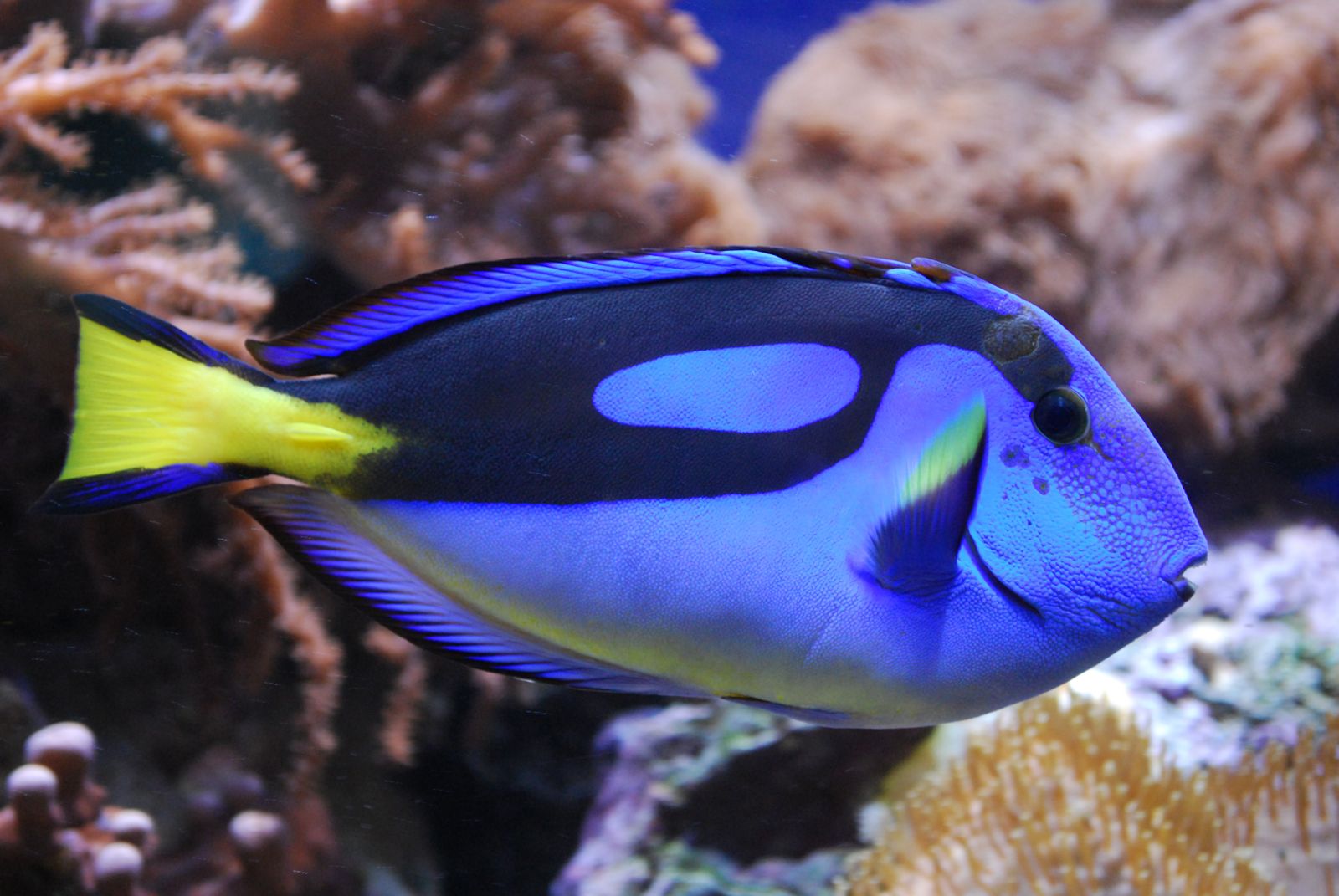
Powder-blue surgeonfish
The fish can reach an average size of 23 cm (9 in) in length. The body has an oval shape and is compressed laterally. Like other surgeonfishes, Acanthurus leucosternon swims with its pectoral fins. The caudal fin has a crescent shape. The fish has a "surgeon's scalpel," an erected part of the spine located at the base of the tail. The mouth is small and pointed in a beak-like manner with tiny and sharp teeth for reaching narrow spaces of food. Its sides are blue; its dorsal fin and the base of caudal fin are yellow; the head is black; the mouth, the throat area, the anal and pelvic fins are white. The pectoral fins are transparent with yellow reflections. The intensity of its blue color shows off if the fish is healthy or not. The fish does not undergo color changes as it matures; as some tangs, surgeonfish and unicornfish do.

Longfin Bannerfish ဆူးတောင်ရှည်ငါး
The pennant coralfish is a small-sized fish that can reach a maximum length of 25 cm. However, the average size generally observed in the nature oscillates around 15 cm. Its body is compressed laterally, the first rays of its dorsal fin stretch in a long white filament. The background color of its body is white with two large black diagonal bands. Beyond the second black stripe, the dorsal and the caudal fins are yellow. The pectoral fins are also yellow. The head is white, the eyes are black and linked together by a black band. The snout, spotted with black, is a bit stretched with a small terminal protractile (it can be extend) mouth. The juvenile doesn't have yet after the second black stripe any white area like adults. The pennant coralfish can easily be confused with the quite similar schooling bannerfish, (Heniochus diphreutes ). The main and visible differences are: a longer snout for the reef bannerfish and spots on its snout are darker, the pelvic fin of the reef bannerfish is longer and has a rounded end unlike the schooling bannerfish which has a smaller and more angular end.
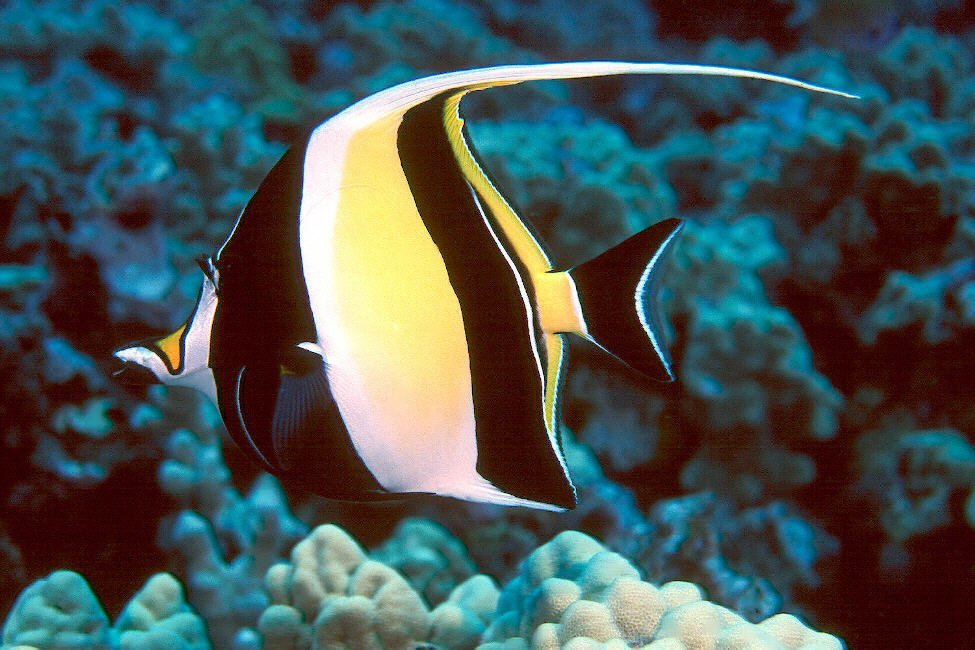
Moorish Idol မိုရီငါး
With distinctively compressed and disk-like bodies, Moorish idols stand out in contrasting bands of black, white, and yellow, which makes them attractive to aquarium keepers. The fish have relatively small fins, except for the dorsal fin, whose six or seven spines are dramatically elongated to form a trailing, sickle-shaped crest called the philomantis extension. Moorish idols have small terminal mouths at the end of long, tubular snouts; many long bristle-like teeth line the mouth. The Moorish idol differs from butterflyfish in having a prominent black, triangular anal fin. The eyes are set high on the fish's deeply keeled body; in adults, perceptible bumps are located above each. The anal fin may have two or three spines. Moorish idols reach a maximum length of 23 cm (9.1 in). The sickle-like dorsal spines shorten with age.
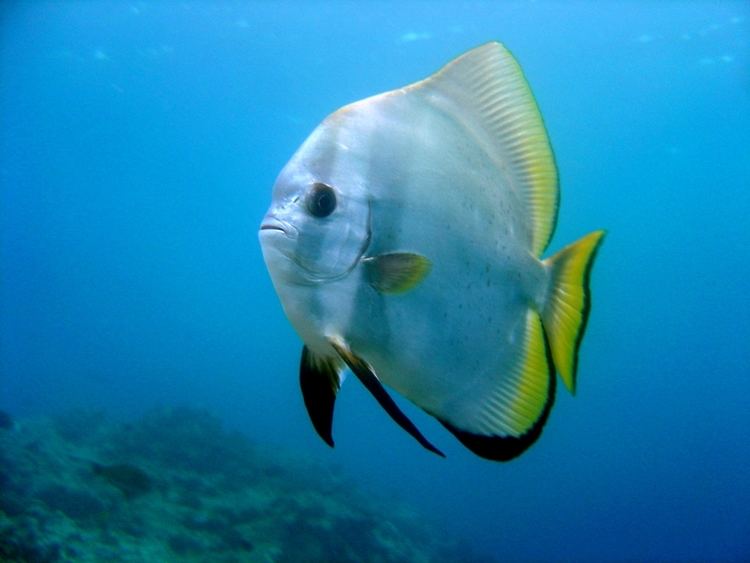
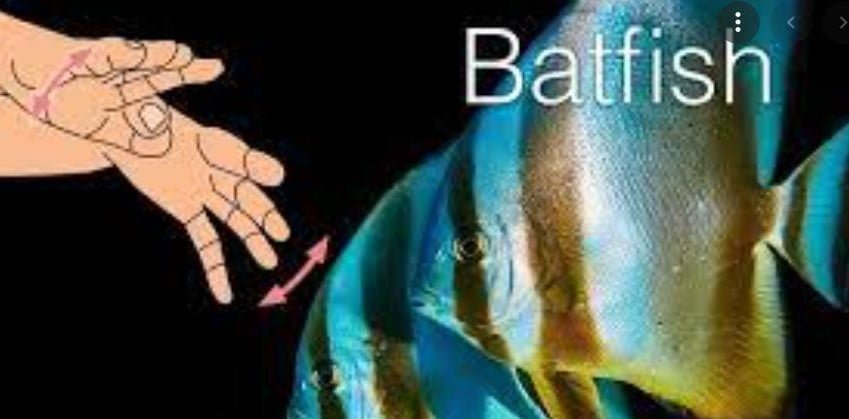
Longfinned Batfish
Platax teira, also known as the teira batfish, longfin batfish, longfin spadefish, or round faced batfish is a fish from the Indo-West Pacific. It occasionally makes its way into the aquarium trade. It grows to a size of 60 cm (24 in) in length. Platax teira has a dark blotch under the pectoral fin, with another long dark mark above the base of the anal fin. Looked at from the side, it has a roughly circular body with a low hump on the nape. This fish is usually silver, grey or brownish. It has a blackish band through the eye and another band with the pectoral fin. They will change colour from silvery white with no bands, to brown with darker banding as you watch, and then fade back to silver again.
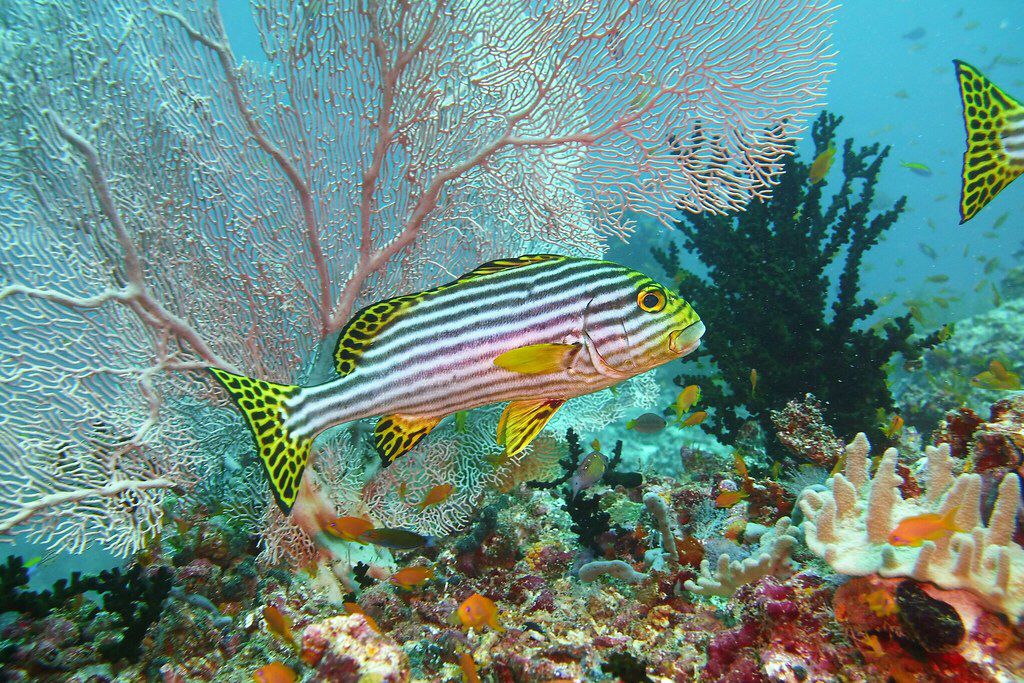
Oriental Sweetlips
The Ocean oriental sweetlips (Plectorhinchus vittatus), also known as the oriental sweetlips or oriental blubberlips, is a species of marine ray-finned fish, a sweetlips belonging to the subfamily Plectorhinchinae, one of two subfamilies in the family Haemulidae, the grunts.
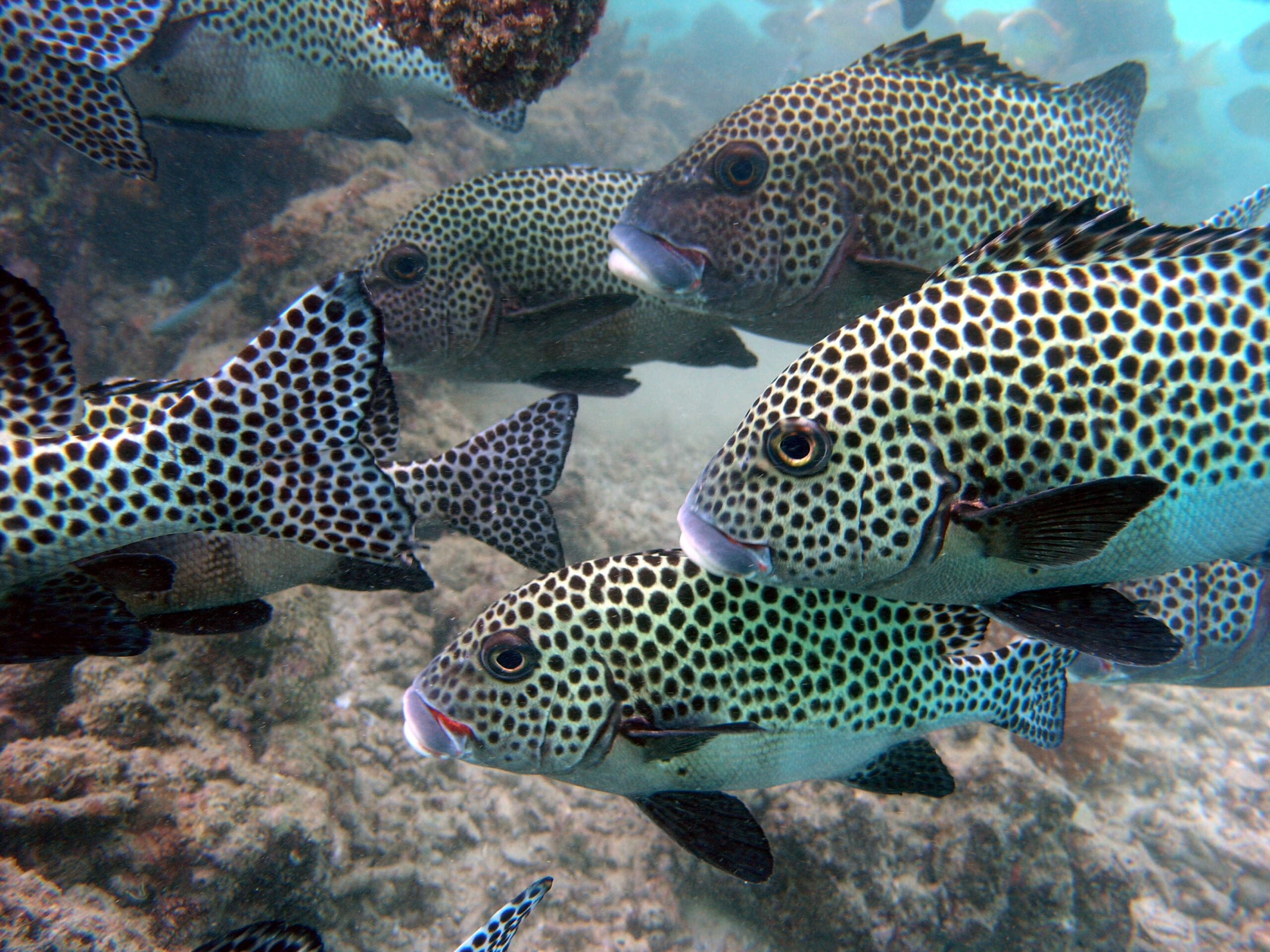
Harlequin Sweetlips
Plectorhinchus chaetodonoides has fleshy lips which become moderately swollen as the fish grows, there are 6 pores on the chin but no central pit. The dorsal fin typically has 12 spines, although rarely it has 11 spines. and 18-20 soft rays, the soft rayed part of the dorsal fin has a height which is roughly equal to the length of its base. The juveniles are brownish with large, discrete creamy white blotches on the body these develop brown spotting as the fish matures. As they grow into adults the coloration slowly develops a greyish background colour broken large, dark brown spots, these spots having a greater diameter of the iris. The maximum recorded total length is 72 cm (28 in), although 60 cm (24 in) is more typical, and the maximum published weight is 7 kg (15 lb). It is thought that the juveniles are Batesian mimics of poisonous flatworms. The caudal fin of juveniles is deeply forked and has wide rounded lobes both of which are mostly white marked with a large brown spot, in adults it is much less forked.
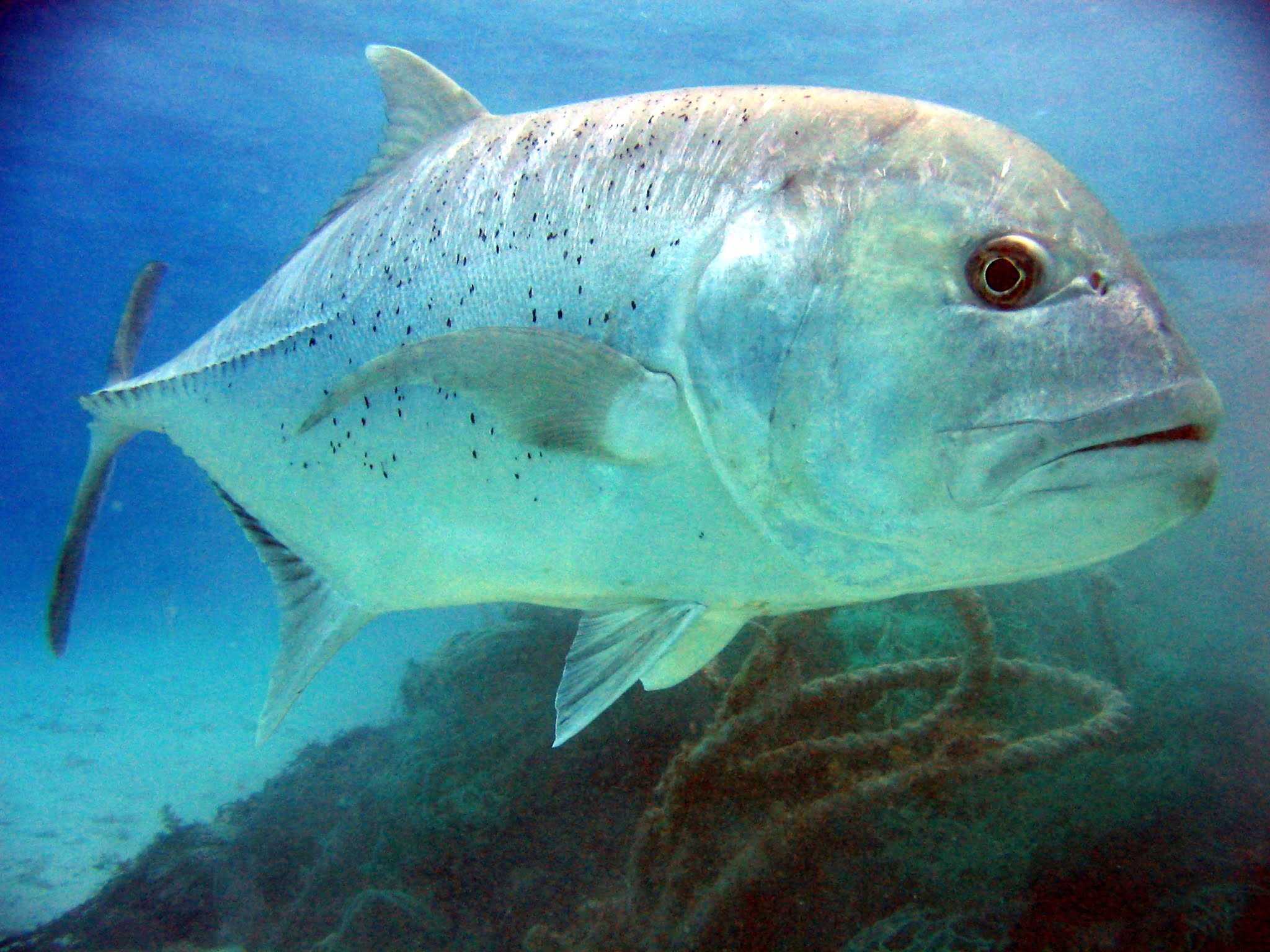
Glant Trevally
The giant trevally (Caranx ignobilis), also known as the lowly trevally, barrier trevally, giant kingfish or ulua, is a species of large marine fish classified in the jack family, Carangidae. The giant trevally is distributed throughout the tropical waters of the Indo-Pacific region, with a range stretching from South Africa in the west to Hawaii in the east, including Japan in the north and Australia in the south. Two were documented in the eastern tropical Pacific in the 2010s (one captured off Panama and another sighted at the Galápagos), but it remains to be seen if the species will become established there. The giant trevally is distinguished by its steep head profile, strong tail scutes, and a variety of other more detailed anatomical features. It is normally a silvery colour with occasional dark spots, but males may be black once they mature. It is the largest fish in the genus Caranx, growing to a maximum known size of 170 cm (67 in) and a weight of 80 kg (176 lbs). The giant trevally inhabits a wide range of marine environments, from estuaries, shallow bays and lagoons as a juvenile to deeper reefs, offshore atolls and large embayments as an adult. Juveniles of the species are known to live in waters of very low salinity such as coastal lakes and upper reaches of rivers, and tend to prefer turbid waters.
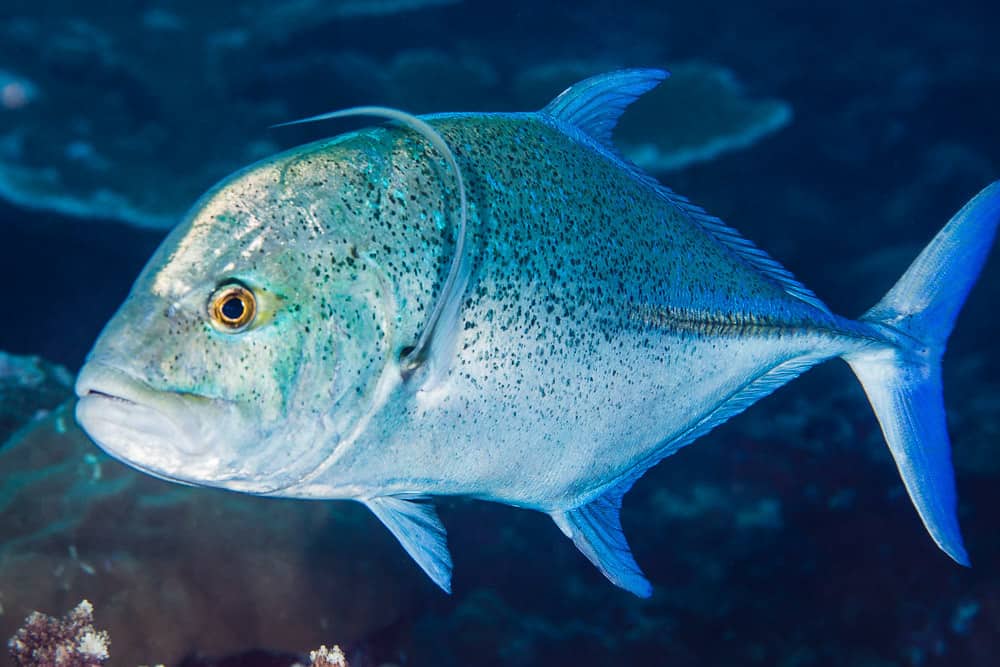
Bluefin Trevally
The bluefin trevally (Caranx melampygus), also known as the bluefin jack, bluefin kingfish, bluefinned crevalle, blue ulua, omilu, and spotted trevally), is a species of large, widely distributed marine fish classified in the jack family, Carangidae. The bluefin trevally is distributed throughout the tropical waters of the Indian and Pacific Oceans, ranging from Eastern Africa in the west to Central America in the east, including Japan in the north and Australia in the south. The species grows to a maximum known length of 117 cm and a weight of 43.5 kg, however is rare above 80 cm. Bluefin trevally are easily recognised by their electric blue fins, tapered snout and numerous blue and black spots on their sides. Juveniles lack these obvious colours, and must be identified by more detailed anatomical features such as fin ray and scute counts. The bluefin trevally inhabits both inshore environments such as bays, lagoons and shallow reefs, as well as deeper offshore reefs, atolls and bomboras. Juveniles prefer shallower, protected waters, even entering estuaries for short periods in some locations.

Titan Triggerfish
The titan triggerfish, giant triggerfish or moustache triggerfish (Balistoides viridescens) is a large species of triggerfish found in lagoons and at reefs to depths of 50 m (160 ft) in most of the Indo-Pacific, though it is absent from Hawaii. With a length of up to 75 centimetres (30 in), it is the largest species of triggerfish in its range (the stone triggerfish, Pseudobalistes naufragium, from the east Pacific is larger).
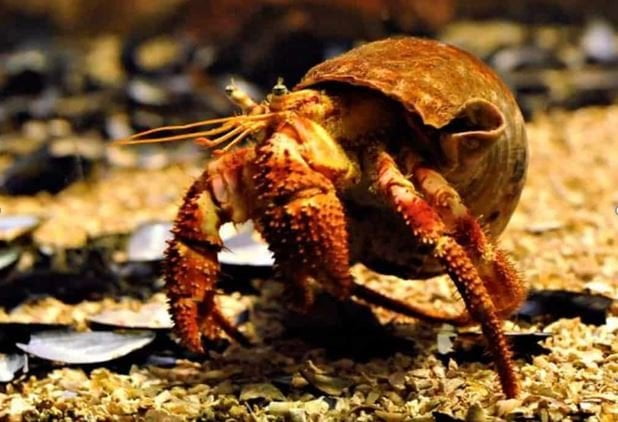
Hermit crabs
Hermit crabs are anomuran decapod crustaceans of the superfamily Paguroidea that have adapted to occupy empty scavenged mollusc shells to protect their fragile exoskeletons. There are over 800 species of hermit crab, most of which possess an asymmetric abdomen concealed by a snug-fitting shell. Hermit crabs' non-calcified abdominal exoskeleton makes their exogenous shelter system obligatory. Hermit crabs must occupy shelter produced by other organisms, or risk being defenseless. The strong association between hermit crabs and their shelters has significantly influenced their biology. Almost 800 species carry mobile shelters (most often calcified snail shells); this protective mobility contributes to the diversity and multitude of crustaceans found in almost all marine environments.
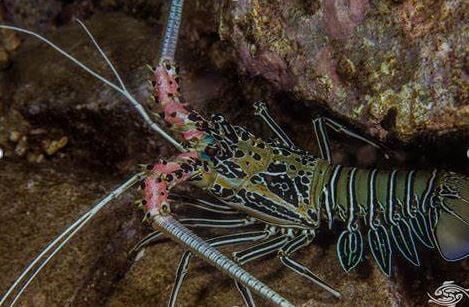
Painted Spiny Lobster
Painted spiny lobster grow to a maximum length of 40 centimeters but most are smaller around the 25 to 40 cm range. The body is covered in a hard carapace covered in spines with two prominent forward facing spines between the eyes. The tail is covered in a segmented carapace allowing it to flex and provide powerful rearwards propulsion. The tail has a fan on the end with assists with the propulsion when flared out. Painted spiny lobsters have separate sexes and at maturity which is generally around four to five years they begin breeding. Males deposit a sperm packet on the underside of females and after they ripen they release up to 100000 eggs which are carried under the females’ tail. Females have specialized attachments (pleopods) on the underside of the tail for the eggs to hook onto.

Crown of thorns starfish
The crown-of-thorns starfish, Acanthaster planci, is a large starfish that preys upon hard, or stony, coral polyps (Scleractinia). The crown-of-thorns starfish receives its name from venomous thorn-like spines that cover its upper surface, resembling the biblical crown of thorns. It is one of the largest starfish in the world.
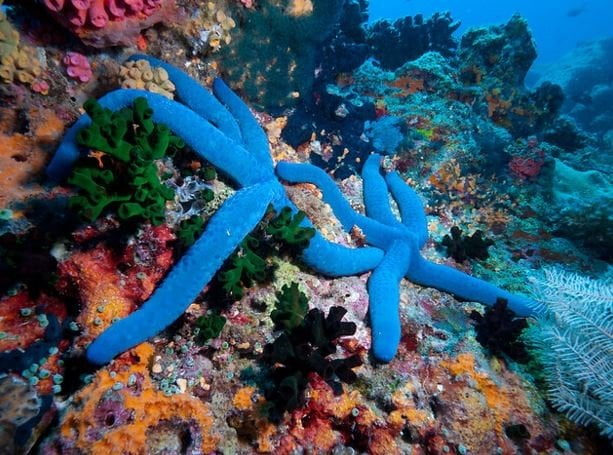
Sea Stars
Sea Stars have remarkable regenerative powers, when attacked and damaged by predators they are able to grow new arms. They usually have five arms but have been found with 4 or 6 arms, this may be because more than one arm has been damaged at one time! Sometimes small parasitic limpets can be found on the underside of arms which can deform the arms. They possess a cleverly evolved arsenal of hydraulic tube feet connected to an elaborate water-vascular system that encircles the animal's mouth and extends via five radial canals down the center of each arm. Their mouth is underneath, but their prey is absorbed outside their mouths by forcing out their digestive organs from their stomach. Sea Stars are carnivores and feed on almost any food including molluscs, worms, detritus and each other! Some sea stars like the crown of thorns can be venomous.
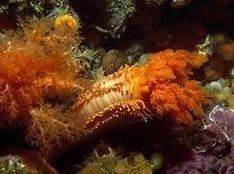
Orange spiked sea cucumber
The average Sea Cucumber grows between 3.9 to 12”. Sea cucumbers has elongated, cylindrical bodies which are red, black, blue, green or brown in color. They have soft bodies even though they have some sort of skeleton below the surface of their body. The skeleton usually consists of plates and spines. These structures can be exposed and used against predators (sea cucumbers are not tasty meal when their bodies suddenly harden). Sea cucumbers use an interesting technique when they are faced with danger. They are able to expel internal organs along with toxic substance (called holothurin) towards the predator and all expelled/missing organs regenerated within 1.5 to 5 weeks.

Starfish
Starfish or sea stars are star-shaped echinoderms belonging to the class Asteroidea. Common usage frequently finds these names being also applied to ophiuroids, which are correctly referred to as brittle stars or basket stars. Starfish are also known as asteroids due to being in the class Asteroidea. About 1,900 species of starfish occur on the seabed in all the world's oceans, from warm, tropical zones to frigid, polar regions. They are found from the intertidal zone down to abyssal depths, at 6,000 m (20,000 ft) below the surface.
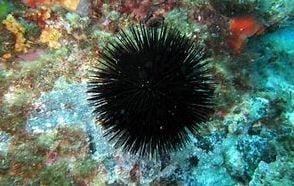
Sea Urchin
It is the most abundant and important herbivore on the coral reefs of the western Atlantic and Caribbean basin. When the population of these sea urchins is at a healthy level, they are the main grazers which prevent algae overgrowth of the reef.

Squamosa Clam
The Squamosa Clam Tridacna squamosa is a subtle beauty. It is most commonly found with a warm brown mantle patterned with many golden brown or yellow wavy lines. Yet one of its most most striking attributes can be the contrast on the mantle. The darker background is generally accented with lighter colored spots and wavy lines, however, it can also be strong in color. There are varieties with green and blue spotting, and they have also occurred with rose and purple coloring.
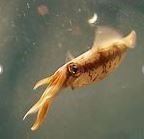
Bigfin Reef Squid
Bigfin reef squids are characterised by a large oval fin that extends throughout the margins of its mantle, giving them a superficial similarity to cuttlefish. They are small to medium-sized squids, averaging 3.8 to 33 centimetres (1.5 to 13.0 in) in length. They exhibit elaborate mating displays and usually spawn in May, but it can vary by location. The paralarvae resemble miniature adults and are remarkable for already having the capability to change body colouration upon hatching. Bigfin reef squids have the fastest recorded growth rates of any large marine invertebrate, reaching 600 g (1.3 lb) in only four months. They are a short-lived species, with a maximum recorded lifespan of 315 days.

Pharaoh cuttlefish
The pharaoh cuttlefish (Sepia pharaonis) is a large cuttlefish species, growing to 42 cm in mantle length and 5 kg in weight.[2] It is also known as seiche pharaon.[3] Sepia pharaonis is likely a complex of at least three species, Sepia pharaonis I, commonly located in the Red Sea and Persian Gulf, S. pharaonis II, located from Japan to the Gulf of Thailand and northern Australia; and S. pharaonis III, located from the Indian Ocean to the Andaman Sea.
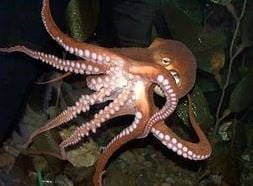
Reef Octopus
The Caribbean reef octopus is a coral reef marine animal. It has eight long arms that vary in length and diameter. The mantle is large and chunky in comparison. This species is difficult to describe because it changes color and texture to blend into its surroundings, using specialised skin cells known as chromatophores. Its color range is very large; it can change from crimson to green, and bumpy to smooth. It weighs around 3.3 lb or 1.5 kg.

Rabbitfish ငါးရန်ရှာ
Rabbitfishes or spinefoots are perciform fishes in the family Siganidae. The 29 species are in a single genus, Siganus. In some now obsolete classifications, the species having prominent face stripes—colloquially called foxfaces–are in the genus Lo. Other species, such as the masked spinefoot (S. puellus), show a reduced form of the stripe pattern. Rabbitfishes are native to shallow waters in the Indo-Pacific, but S. luridus and S. rivulatus have become established in the eastern Mediterranean via Lessepsian migration. They are commercially important food fish, and can be used in the preparation of dishes such as bagoong.
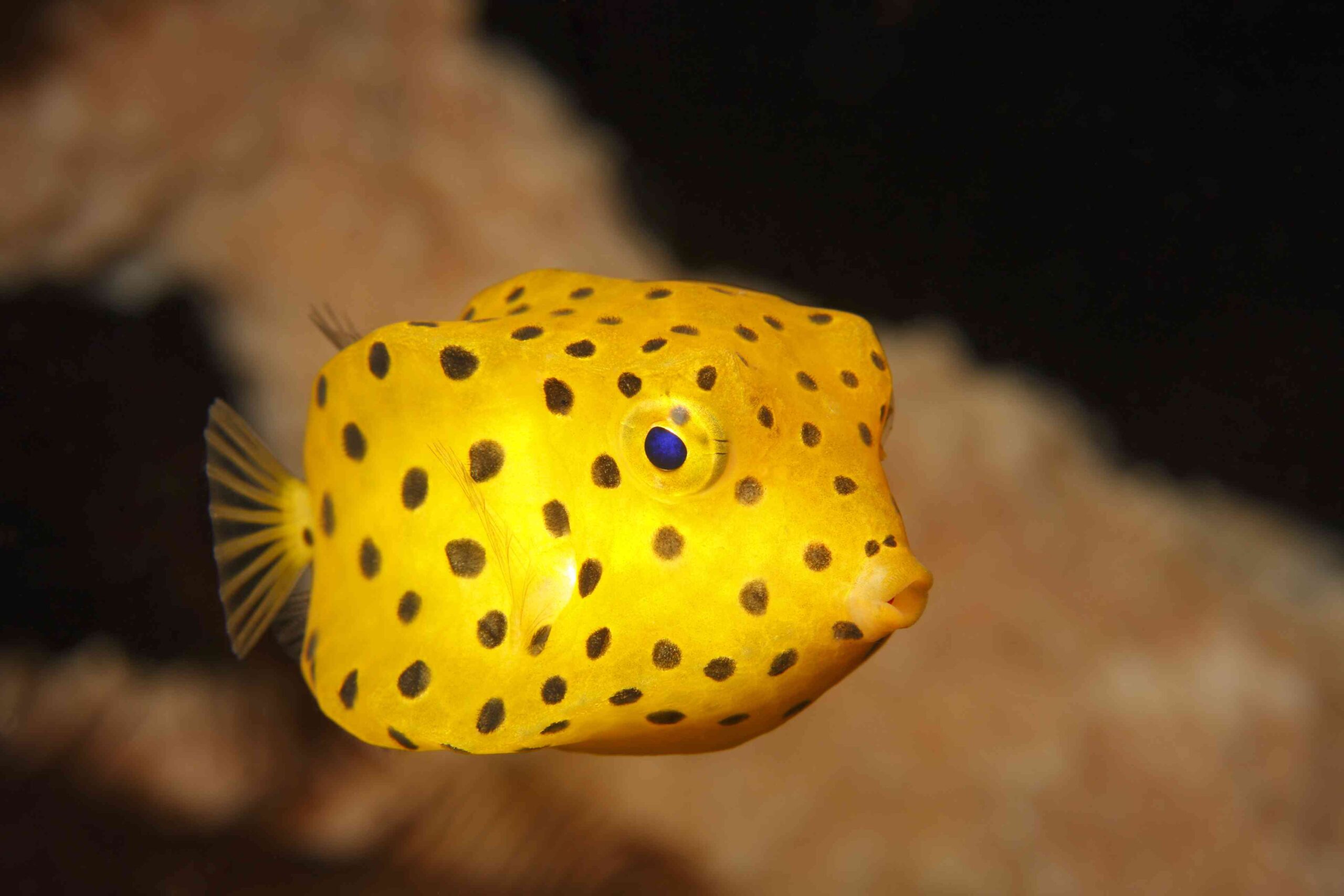
Boxfish သေတ္တာငါး
ခန္ဓာကိုယ်အများစုကို ဖုံးလွှမ်းထားတဲ့ မာကျောပြီး အကာအကွယ်ပေးတဲ့ ကာရာကွက်လို့လည်း ခွဲခြားထားတဲ့ အိုစထရာစီယန်တီဒါ (သို့မဟုတ် Ostraciidae) မျိုးရင်းထဲက ရေတိမ်တဲ့ ရေငါးအုပ်စုငယ်တစ်စုထဲက အုပ်စုငယ်တစ်စုထဲက အုပ်စုငယ်တစ်စုထဲက တစ်ခုခုပါဝင်ပါတယ်။ နွားငါးဟူသော ရွေးချယ်မှုအမည်မှာ မျိုးစိတ်တချို့၏ ဦးခေါင်းများပေါ်ရှိ ဦးချိုနှင့်တူသော ခန့်မှန်းချက်များကို ရည်ညွှန်းသည်။ ကမ္ဘာတစ်ဝန်းတွင် နွေးထွေးပြီး အပူပိုင်းအပူပိုင်း ပင်လယ်များတွင် တွေ့ရသော မိသားစုဝင်များသည် စားစရာကောင်းပြီး စူးစမ်းလိုစိတ်များအဖြစ် ခြောက်သွေ့လေ့ရှိကြသည်။ မျက်လုံးများမှလွဲ၍ မျက်စိနိမ့်ပါး၊ တောင်ပံနှင့် အမြီးတို့မှလွဲ၍ လက်ဝှေ့ငါးများကို တင်းကျပ်သော ရပ်ကွက်တွင် ဝိုင်းထားသည်။ ဤဖုံးအုပ်ထားသော ပန်းကန်ပြားများပါဝင်ပြီး ငါးမျိုးစိတ်များအပေါ်မူတည်၍ ကန့်လန့်ဖြတ်အပိုင်းတွင် ကြမ်းတမ်းသော တြိဂံ၊ စတုရန်း သို့မဟုတ် ပင်တဂွန်ပုံသဏ္ဌာန်ရှိသည်။ သေတ္တာငှက်များသည် အလွန်ဆွဲဆောင်မှုရှိသော အရောင်များဖြစ်လေ့ရှိသည်။ သေးငယ်ပြီး အကြီးဆုံး ကြီးထွားမှုမှာ စင်တီမီတာ ၅၀ (၂၀ လက်မ) ခန့်အထိ ရှည်လျားသည်။ ဖမ်းဆီးကိုင်တွယ်ပြီး ကိုင်တွယ်သည့်အခါ သေတ္တာငါးများသည် ၎င်းတို့နှင့်အတူ ထိန်းသိမ်းထားသော အခြားငါးများကို သေစေနိုင်သည့် အဆိပ်အတောက်ပစ္စည်းတစ်ခုကို ထုတ်ဖော်ပြောဆိုကြသည်။
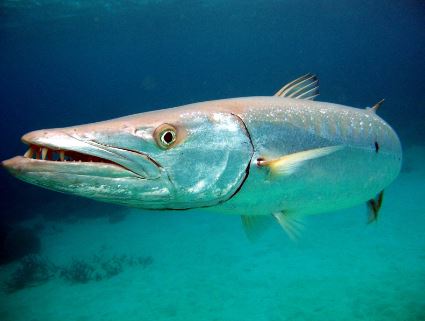
Barracuda Fish ဘာရာကူဒါငါး
ဘာရာကူဒါသည် မြွေကဲ့သို့ အသွင်အပြင်မျိုးရှိသည်။ အထင်ကရ၊ ထက်မြက်တဲ့၊ မြွေလို သွားတွေပါရှိတယ်။ ပီရာနဟာလိုမျိုး၊ အရွယ်အစားအမျိုးမျိုးရှိတယ်။ မေးရိုးကြီးတွေရဲ့ ခြေအိတ်တွေမှာ တပ်ဆင်ထားပါတယ်။ ယင်းတို့တွင် မျိုးစိတ်များစွာတွင် ကိုက်ခံရသည့် ဦးခေါင်းကြီးများရှိသည်။ သူတို့ရဲ့အဖုံးတွေမှာ ကျောရိုးမရှိတဲ့အတွက် အကြေးခွံလေးတွေနဲ့ ဖုံးထားတယ်။ သူ တို့ ၏ အိပ်ခန်း နှစ် ခု ကို ကျယ်ကျယ်ပြန့်ပြန့် ခွဲခြား ထား ပြီး ၊ အရှေ့ဘက် အရှေ့ ဘက် တွင် ကျောရိုး ငါး ချောင်း ရှိ ပြီး ၊ ကျောရိုး တစ် လုံး နှင့် နူးညံ့ သော ရောင်ခြည် ကိုး ခု ရှိ သည် ။ ပိုစထရီယားအိုးကတော့ ဆေးပင်နဲ့ အရွယ်အစားနဲ့ ဆင်တူပြီး အဲဒီအထက်မှာ တည်ရှိတယ်။ ဘေးမျဉ်းသည် အထင်ကရဖြစ်ပြီး ဦးခေါင်းမှ အမြီးအထိ တိုက်ရိုက်ကျယ်ပြန့်သည်။ လည်ပတ်နေတဲ့ အိပ်ငွေ့ကို တင်ပါးဆုံရိုးအထက်မှာ ထားပြီး ပုံမှန်အားဖြင့် သစ်ခုတ်ထဲမှာ ပြန်ရုပ်သိမ်းထားတယ်။ ကျောက်ကပ်တောင်ပံကို ၎င်း၏ပိုစတာအစွန်းနှစ်ဖက်ဖြင့် အတော်အသင့်ဖုံးထားပြီး ခိုင်ခံ့သောခြေနင်းတစ်ချောင်း၏အဆုံးတွင် ချမှတ်ထားသည်။ တောင်ပံတောင်ပံများကို ဘေးဘက်တွင် နိမ့်ကျစေသည်။ ရေကူးခွက်သည် ကြီးမားပြီး ခရီးသွားနေစဉ် သို့မဟုတ် အလုပ်လက်မရှိဘဲ ကျန်ရှိနေစဉ် စွမ်းအင်ကုန်ကျစရိတ်အနည်းဆုံးအတွက် ခွင့်ပြုသည်။ အများအားဖြင့် ဘာရာကူဒါသည် အဖြူရောင် အဖြူရောင်၊ အဖြူရောင် သို့မဟုတ် အပြာရောင်ဖြစ်ပြီး ငှက်ပျောသီးဖြူနှင့် ဝမ်းဖြူပါရှိသည်။ အရောင်သည် မျိုးစိတ်များစပ်ကြား အတော်အတန်ကွဲပြားသည်။ မျိုးစိတ်တချို့အတွက် ပုံမှန်မဟုတ်တဲ့ အနက်ရောင် အစက်အပြောက်တွေ ဒါမှမဟုတ် ပိုနက်တဲ့ ဘားတန်းတွေဟာ တစ်ဖက်စီမှာ ဖြစ်ပေါ်လာတယ်။ သူတို့ရဲ့တောင်ပံတွေဟာ အဝါရောင် ဒါမှမဟုတ် ညနေစောင်းဖြစ်နိုင်တယ်။ ဘာရာကူဒက်စ်သည် အဓိကအားဖြင့် သမုဒ္ဒရာများတွင် နေထိုင်ကြသော်လည်း မဟာဘာရာကူဒါကဲ့သို့သော မျိုးစိတ်အချို့မှာမူ ဘရိတ်ရေတွင် နေထိုင်ကြသည်။ ဆင်တူချက်များကြောင့် တစ်ခါတစ်ရံ ဘာရာကူဒါကို ရေချိုပိုက်နှင့် နှိုင်းယှဉ်ထားသော်လည်း နှစ်ခုကြား အဓိကကွာခြားချက်မှာ ဘာရာကူဒါတွင် ရေချိုပိုက်နှင့်မတူဘဲ ခေါက်ထားသော အမြီးနှင့် သီးခြားအိပ်ဆောင်တောင်နှစ်ခုရှိသည်။
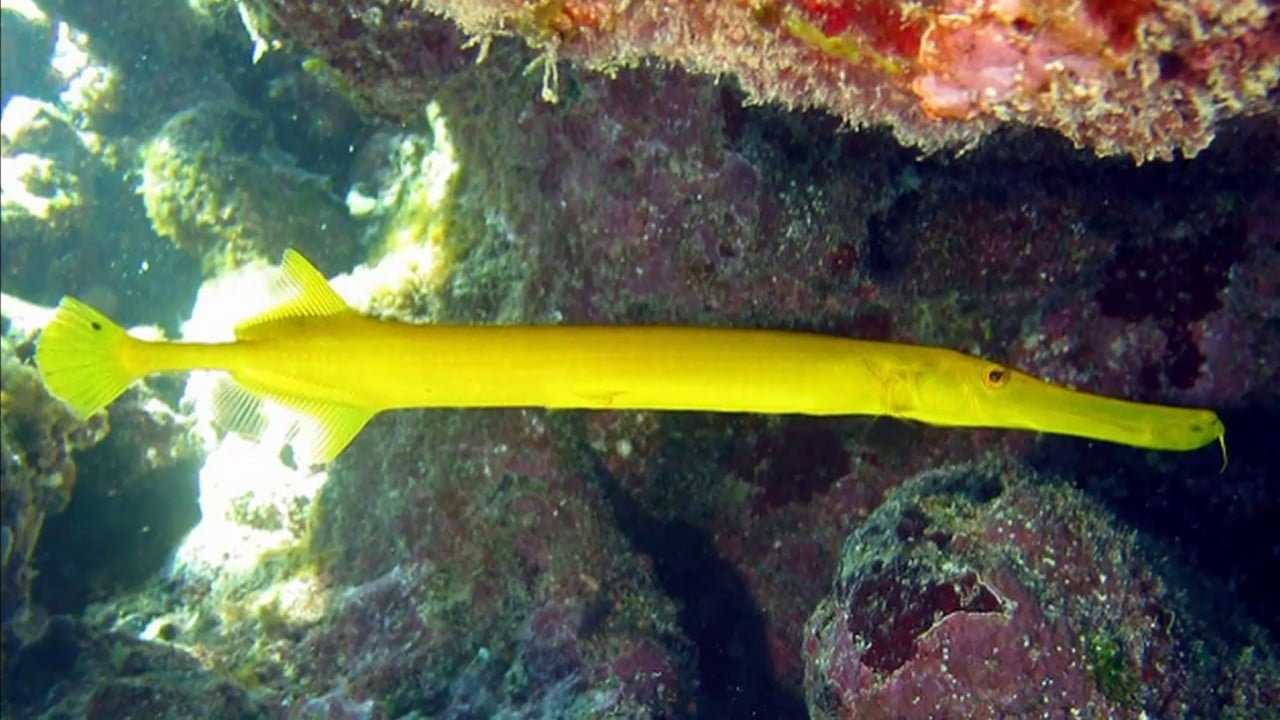
Trumpet fish ထရမ့်ငါး
အတ္တလန္တိတ်သမုဒ္ဒရာတွင် မျိုးစိတ်နှစ်မျိုးနှင့် အင်ဒို-ပစိဖိတ်တွင် မျိုးစိတ်နှစ်မျိုးရှိသည့် ကမ္ဘာတစ်ဝန်းရှိ အပူပိုင်းရေပြင်များတွင် ထရမ့်ငါးများကို တွေ့ရှိရသည်။ ယင်းတို့သည် အများအားဖြင့် သန္တာကျောက်တန်းနေထိုင်သူများဖြစ်ကြပြီး ထိုတွင် မျိုးစိတ်တစ်ခုသည် ကျောက်ဆောင်ထူထူကို နှစ်သက်ပုံရသည်။ သန္တာကျောက်တန်းငါးများအတွက် အတော်အတန်ကြီးမားပြီး ထိုတွင် ၁ မီတာနီးပါးအထိ ရှည်လျားသည်။ တံပိုးခရာငါးများ၏ အလောင်းများမှာ တံပိုးမှုန့်၊ တင်းကျပ်ပြီး ပန်းပုံသဏ္ဍာန်များဖြစ်သည်။ သူ တို့ ၏ အိပ်ခန်း နှင့် ဆေးခြောက် တောင်ပံ များ သည် အမြီး နှင့် အနီးကပ် ရှိ သည် ၊ ထို နေရာ တွင် အိပ်ခန်း တစ် ခု ချင်း စီ ၏ ကျောရိုး များ သည် ခေါင်းပိုင်း ဒေသ ဆီသို့ လမ်းလယ် သို့ ရောက် ရှိ သည် ။ Syngnathiformes အမိန့်အရ အဖွဲ့ဝင်အများစုလိုပဲ တံပိုးမှုတ်တဲ့ငါးတွေရဲ့ ကိုယ်ခန္ဓာတွေဟာ အရိုးအဆက်အသွယ်တွေရဲ့ ထောက်ပံ့မှုနဲ့ ထောက်ပံ့ပေးထားတဲ့ ညှိနှိုင်းလို့မရဘူး။ မိသားစု၏ ကွဲပြားခြားနားသောစရိုက်တစ်ခုမှာ ၎င်းတို့၏ရှည်လျားသောပြွန်များဖြစ်ပြီး စာမူမပါသည့် မေးရိုးများဖြင့် အဆုံးသတ်သွားသည်။ မိသားစုဝင် များ သည် သူ တို့ ၏ မေးရိုး များ ကို စက်ဝန်း တစ် ခု သို့ လျင်မြန် စွာ တိုး ချဲ့ နိုင် စွမ်း ရှိ ပြီး ၊ အစာကျွေး သောအခါ ကိုယ်ခန္ဓာ ၏ အချင်း နီးပါး အပေါက် နီးပါး ကွာဟ နေ သည်။
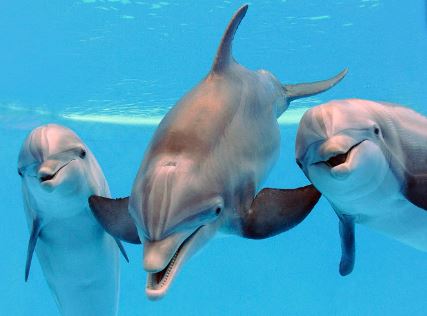
Dolphin လင်းပိုင်
လင်းပိုင်များသည် ပျံ့နှံ့လျက်ရှိသည်။ မျိုးစိတ်အများစုသည် အပူပိုင်းဇုန်များ၏ ပူနွေးသောရေကို ပိုနှစ်သက်ကြသော်လည်း ဝေလငါးလင်းကဲ့သို့သော အချို့မှာမူ ပိုအေးသောရာသီဥတုကို ပို၍ကြိုက်နှစ်သက်ကြသည်။ လင်းဖင်းများသည် ငါးနှင့် ပြည်ကြီးငါးများကို အများအားဖြင့် ကျွေးမွေးကြသော်လည်း အော်ကာကဲ့သို့သော အနည်းငယ်သည် တံဆိပ်များကဲ့သို့သော နို့တိုက်သတ္တဝါကြီးများကို ကျွေးမွေးကြသည်။ လင်းပိုင်အထီးများသည် အများအားဖြင့် နှစ်စဉ် အမများစွာနှင့် တွဲဖက်လေ့ရှိသော်လည်း အမများသည် နှစ်နှစ်မှ သုံးနှစ်တစ်ကြိမ်သာ အိမ်ထောင်ဖက်ဖြစ်ကြသည်။ ကလေးများသည် နွေဦးနှင့် နွေရာသီလများတွင် မွေးဖွားလေ့ရှိပြီး အမျိုးသမီးများသည် ယင်းတို့ကို ပြုစုပျိုးထောင်ရန် တာဝန်ရှိသမျှကို ဆောင်ရွက်ကြသည်။ မျိုးစိတ်တချို့ရဲ့ မိခင်တွေဟာ မြန်မြန်ဆန်ဆန်နဲ့ ကလေးတွေကို အချိန်အတော်ကြာ မွေးမြူပေးကြတယ်။ လင်းပိုင်များသည် အသံအမျိုးမျိုးကို ထုတ်လုပ်လေ့ရှိသည်။ များသောအားဖြင့် နှိပ်စက်ခြင်းနှင့် ခရာမှုတ်ခြင်းပုံစံဖြင့်ဖြစ်သည်။ တစ်ခါတစ်ရံ ဂျပန်ကဲ့သို့သော နေရာများတွင် လင်းကွင်းများကို လိုက်လံဖမ်းဆီးကြသည်။ လင်းဖင်ဒရိုက်အမဲလိုက်ခြင်းဟု လူသိများသည့် လှုပ်ရှားမှုတစ်ခုတွင် လင်းကွင်းများကို အမဲလိုက်ကြသည်။ အမဲလိုက်ခြင်းအပြင် ဖမ်းဆီးခြင်း၊ နေထိုင်ရာဒေသဆုံးၡုံးမှုနှင့် ပင်မညစ်ညမ်းမှုတို့ကြောင့်လည်း ခြိမ်းခြောက်မှုများနှင့် ရင်ဆိုင်ကြရသည်။ ကမ္ဘာတစ်ဝန်းရှိ ယဉ်ကျေးမှုအမျိုးမျိုးတွင် လင်းကွင်းများကို သရုပ်ဖော်ထားသည်။ တစ်ခါတစ်ရံ လင်းပိုင်များကို သုံ့ပန်းဘဝတွင် ထိန်းသိမ်းထားပြီး လှည့်ကွက်များပြုလုပ်ရန် လေ့ကျင့်ပေးကြသည်။ သုံ့ပန်းဘဝတွင် အများဆုံး လင်းပိုင်မျိုးစိတ်များမှာ ပုလင်းနို့လင်းပိုင်ဖြစ်ပြီး သုံ့ပန်းဘဝတွင် အော်ကာ ၆၀ ဝန်းကျင်ရှိသည်။
YANGON HEAD OFFICE
Building (11), MICT Park, Hlaing University Campus, Hlaing Township, Yangon.
info@divinginmyanmar.com
NGWE SAUNG OFFICE
NGAPALI OFFICE
No.(36), Jade Taw Road, Mya Pyin (1) Quarter, Ngapali.
info@divinginmyanmar.com
WEATHER FORECAST
Copyright © 2022 Myanmar Dive Center


